INTERACT Saskatoon Participant VERITAS Summary - W2 - new and returning
Benoit THIERRY
04 April, 2024
1 VERITAS dataset description
Unlike the Eligibility or Health questionnaires, which can mostly be encoded as a flat table, the VERITAS questionnaire implicitly records a series of entities and their relationships:
- Places: list of geocoded locations visited by participants, along with the following characteristics: category, name, visit frequency, transportation mode
- Social contacts: people and/or groups frequented by participants
- Relationships: between social contacts (who knows who / who belongs to which group) as well as between locations and social contacts (places visited along with whom)
The diagram below illustrates the various entities collected throught the VERITAS questionnaire:
New participants and returning participants are presented separately below, as they were presented two slightly different question flows.
2 Basic descriptive statistics for new participants
2.1 Section 1: Residence and Neighbourhood
2.1.1 Now, let’s start with your home. What is your address?
home_location <- locations[locations$location_category == 1, ]
## version ggmap
skt_aoi <- st_bbox(home_location)
names(skt_aoi) <- c("left", "bottom", "right", "top")
skt_aoi[["left"]] <- skt_aoi[["left"]] - .07
skt_aoi[["right"]] <- skt_aoi[["right"]] + .07
skt_aoi[["top"]] <- skt_aoi[["top"]] + .01
skt_aoi[["bottom"]] <- skt_aoi[["bottom"]] - .01
bm <- get_stadiamap(skt_aoi, zoom = 11, maptype = "stamen_toner_lite") %>%
ggmap(extent = "device")
bm + geom_sf(data = st_jitter(home_location, .008), inherit.aes = FALSE, color = "blue", size = 1.8, alpha = .3) # see https://github.com/r-spatial/sf/issues/336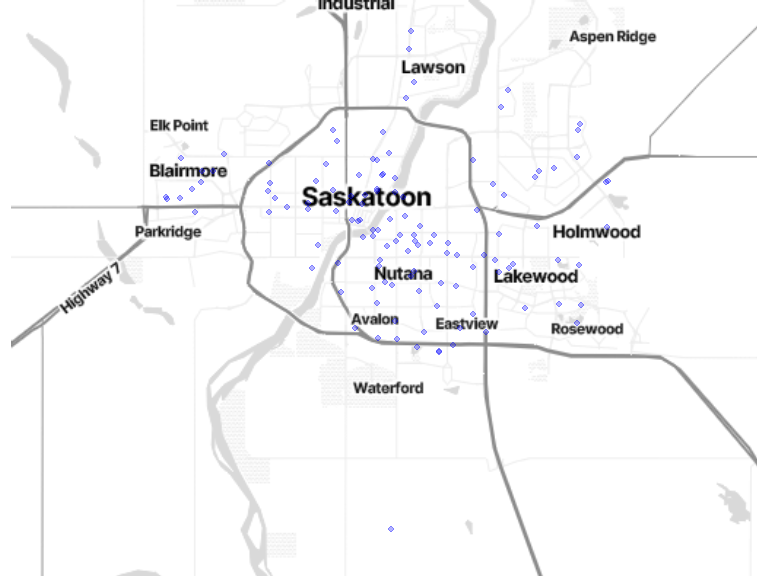
NB: Home locations have been randomly shifted from their original position to protect privacy.
# Number of participants by municipalites
home_by_municipalites <- st_join(home_location, municipalities["NAME"])
home_by_mun_cnt <- as.data.frame(home_by_municipalites) %>%
group_by(NAME) %>%
dplyr::count() %>%
arrange(desc(n), NAME)
home_by_mun_cnt$Shape <- NULL
kable(home_by_mun_cnt, caption = "Number of participants by municipalities") %>% kable_styling(bootstrap_options = "striped", full_width = T, position = "left")| NAME | n |
|---|---|
| Saskatoon | 123 |
| Corman Park | 1 |
2.1.2 If you were asked to draw the boundaries of your neighbourhood, what would they be?
prn <- poly_geom[poly_geom$area_type == "neighborhood", ]
## version ggmap
bm + geom_sf(data = prn, inherit.aes = FALSE, fill = alpha("blue", 0.05), color = alpha("blue", 0.3))
# Min, max, median & mean area of PRN
prn$area_m2 <- st_area(prn$geom)
kable(t(as.matrix(summary(prn$area_m2))),
caption = "Area (in square meters) of the perceived residential neighborhood",
digits = 1
) %>%
kable_styling(bootstrap_options = "striped", full_width = T, position = "left")| Min. | 1st Qu. | Median | Mean | 3rd Qu. | Max. |
|---|---|---|---|---|---|
| 4959.1 | 272957.2 | 742214.6 | 1050349 | 1432838 | 6363390 |
NB only 110 valid neighborhoods were collected, as many participants struggled to draw polygons on the map.
2.1.3 How attached are you to your neighbourhood?
# extract and recode
.ngh_att <- veritas_main[veritas_main$neighbourhood_attach != 99, c("interact_id", "neighbourhood_attach")] %>% dplyr::rename(neighbourhood_attach_code = neighbourhood_attach)
.ngh_att$neighbourhood_attach <- factor(ifelse(.ngh_att$neighbourhood_attach_code == 1, "1 [Not attached at all]",
ifelse(.ngh_att$neighbourhood_attach_code == 6, "6 [Very attached]",
.ngh_att$neighbourhood_attach_code
)
))
# histogram of attachment
ggplot(data = .ngh_att) +
geom_histogram(aes(x = neighbourhood_attach), stat = "count") +
scale_x_discrete(labels = function(lbl) str_wrap(lbl, width = 20)) +
labs(x = "neighbourhood_attach")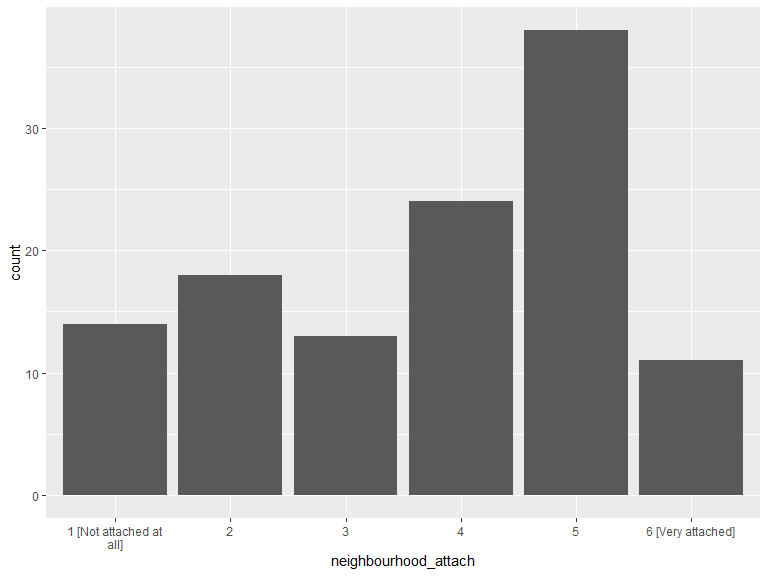
.ngh_att_cnt <- .ngh_att %>%
group_by(neighbourhood_attach) %>%
dplyr::count() %>%
arrange(neighbourhood_attach)
kable(.ngh_att_cnt, caption = "Neigbourhood attachment") %>%
kable_styling(bootstrap_options = "striped", full_width = T, position = "left")| neighbourhood_attach | n |
|---|---|
| 1 [Not attached at all] | 14 |
| 2 | 18 |
| 3 | 13 |
| 4 | 24 |
| 5 | 38 |
| 6 [Very attached] | 11 |
2.1.4 On average, how many hours per day do you spend outside of your home?
# histogram of n hours out
ggplot(data = veritas_main) +
geom_histogram(aes(x = hours_out))
# Min, max, median & mean hours/day out
kable(t(as.matrix(summary(veritas_main$hours_out))),
caption = "Hours/day outside home",
digits = 1
) %>%
kable_styling(bootstrap_options = "striped", full_width = T, position = "left")| Min. | 1st Qu. | Median | Mean | 3rd Qu. | Max. |
|---|---|---|---|---|---|
| 1 | 2 | 4 | 5.7 | 9 | 24 |
2.1.5 Of this time spent outside your home, on average how many hours do you spend outside your neighbourhood?
# histogram of n hours out
ggplot(data = veritas_main) +
geom_histogram(aes(x = hours_out_neighb))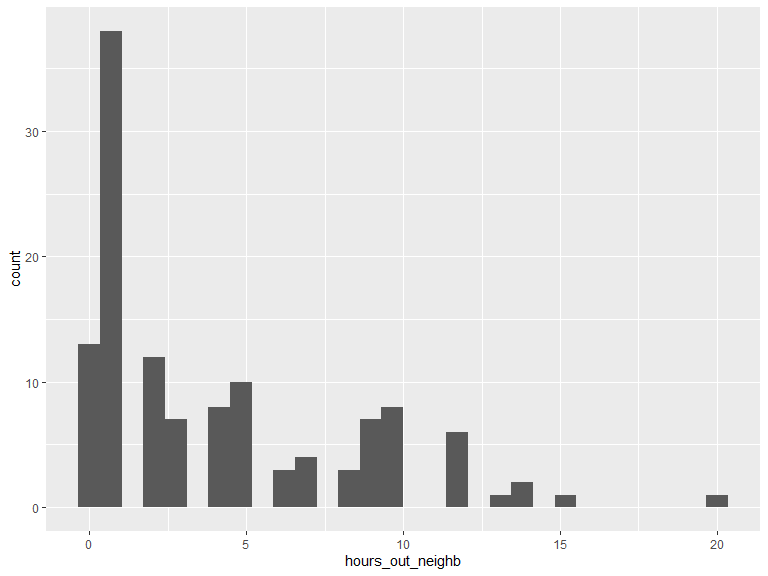
# Min, max, median & mean hours/day out of neighborhood
kable(t(as.matrix(summary(veritas_main$hours_out_neighb))),
caption = "Hours/day outside neighbourhood",
digits = 1
) %>%
kable_styling(bootstrap_options = "striped", full_width = T, position = "left")| Min. | 1st Qu. | Median | Mean | 3rd Qu. | Max. |
|---|---|---|---|---|---|
| 0 | 1 | 2 | 4.2 | 7 | 20 |
2.1.6 Are there one or more areas close to where you live that you tend to avoid because you do not feel safe there (for any reason)?
# extract and recode
.unsafe <- veritas_main[c("interact_id", "unsafe_area")] %>% dplyr::rename(unsafe_area_code = unsafe_area)
.unsafe$unsafe_area <- factor(ifelse(.unsafe$unsafe_area_code == 1, "1 [Yes]",
ifelse(.unsafe$unsafe_area_code == 2, "2 [No]", "N/A")
))
# histogram of answers
ggplot(data = .unsafe) +
geom_histogram(aes(x = unsafe_area), stat = "count") +
scale_x_discrete(labels = function(lbl) str_wrap(lbl, width = 20)) +
labs(x = "unsafe_area")
.unsafe_cnt <- .unsafe %>%
group_by(unsafe_area) %>%
dplyr::count() %>%
arrange(unsafe_area)
kable(.unsafe_cnt, caption = "Unsafe areas") %>% kable_styling(bootstrap_options = "striped", full_width = T, position = "left")| unsafe_area | n |
|---|---|
| 1 [Yes] | 30 |
| 2 [No] | 94 |
# map
unsafe <- poly_geom[poly_geom$area_type == "unsafe area", ]
## version ggmap
bm + geom_sf(data = unsafe, inherit.aes = FALSE, fill = alpha("blue", 0.3), color = alpha("blue", 0.5))
# Min, max, median & mean area of PRN
unsafe$area_m2 <- st_area(unsafe$geom)
kable(t(as.matrix(summary(unsafe$area_m2))),
caption = "Area (in square meters) of the perceived unsafe area",
digits = 1
) %>%
kable_styling(bootstrap_options = "striped", full_width = T, position = "left")| Min. | 1st Qu. | Median | Mean | 3rd Qu. | Max. |
|---|---|---|---|---|---|
| 1345.1 | 54800.9 | 256594.1 | 3632394 | 1809054 | 68822075 |
2.1.7 Do you spend the night somewhere other than your home at least once per week?
# extract and recode
.o_res <- veritas_main[c("interact_id", "other_resid")] %>% dplyr::rename(other_resid_code = other_resid)
.o_res$other_resid <- factor(ifelse(.o_res$other_resid_code == 1, "1 [Yes]",
ifelse(.o_res$other_resid_code == 2, "2 [No]", "N/A")
))
# histogram of answers
ggplot(data = .o_res) +
geom_histogram(aes(x = other_resid), stat = "count") +
scale_x_discrete(labels = function(lbl) str_wrap(lbl, width = 20)) +
labs(x = "other_resid")
.o_res_cnt <- .o_res %>%
group_by(other_resid) %>%
dplyr::count() %>%
arrange(other_resid)
kable(.o_res_cnt, caption = "Other residence") %>% kable_styling(bootstrap_options = "striped", full_width = T, position = "left")| other_resid | n |
|---|---|
| 1 [Yes] | 18 |
| 2 [No] | 106 |
2.2 Section 2: Occupation
2.2.1 Are you currently working?
# extract and recode
.work <- veritas_main[c("interact_id", "working")] %>% dplyr::rename(working_code = working)
.work$working <- factor(ifelse(.work$working_code == 1, "1 [Yes]",
ifelse(.work$working_code == 2, "2 [No]", "N/A")
))
# histogram of answers
ggplot(data = .work) +
geom_histogram(aes(x = working), stat = "count") +
scale_x_discrete(labels = function(lbl) str_wrap(lbl, width = 20)) +
labs(x = "working")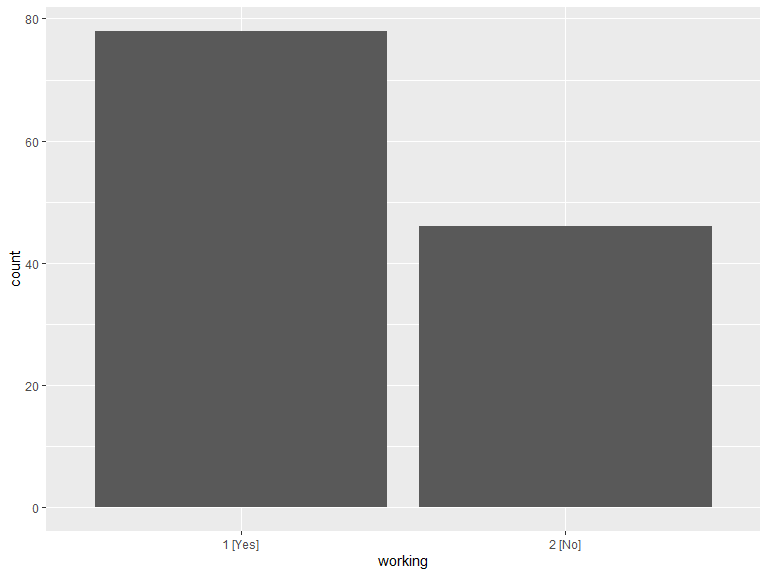
.work_cnt <- .work %>%
group_by(working) %>%
dplyr::count() %>%
arrange(working)
kable(.work_cnt, caption = "Currently working") %>%
kable_styling(bootstrap_options = "striped", full_width = T, position = "left")| working | n |
|---|---|
| 1 [Yes] | 78 |
| 2 [No] | 46 |
2.2.2 Where do you work?
work_location <- locations[locations$location_category == 3, ]
bm + geom_sf(data = work_location, inherit.aes = FALSE, color = "blue", size = 1.8, alpha = .3)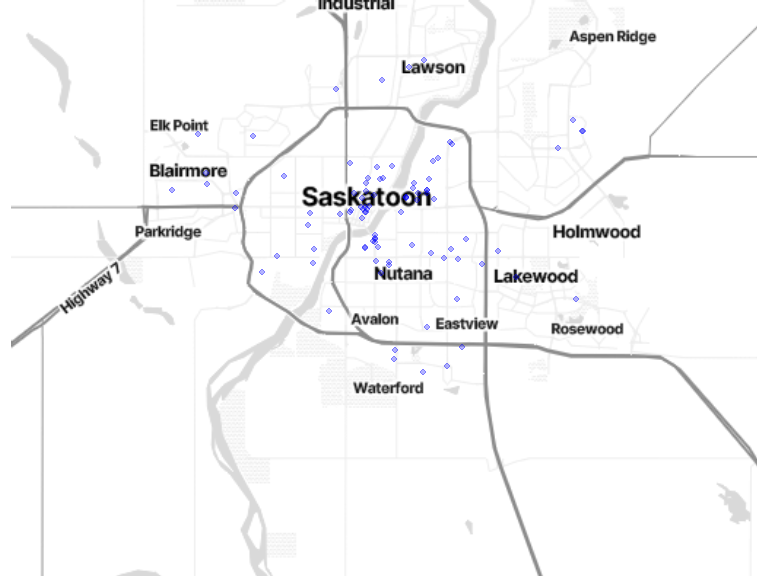
2.2.3 On average, how many hours per week do you work?
# histogram of n hours out
ggplot(data = veritas_main[veritas_main$working == 1, ]) +
geom_histogram(aes(x = work_hours))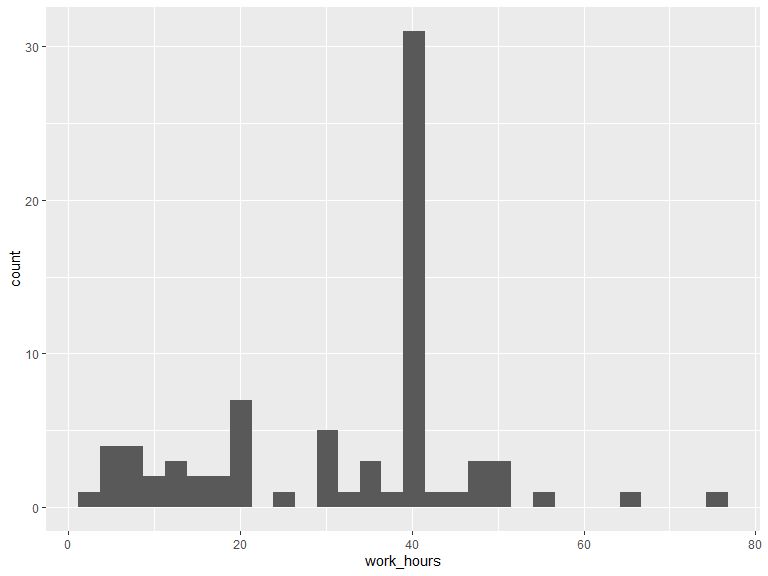
# Min, max, median & mean hours/day out
kable(t(as.matrix(summary(veritas_main$work_hours[veritas_main$working == 1]))),
caption = "Work hours/week",
digits = 1
) %>%
kable_styling(bootstrap_options = "striped", full_width = T, position = "left")| Min. | 1st Qu. | Median | Mean | 3rd Qu. | Max. |
|---|---|---|---|---|---|
| 2 | 20 | 40 | 31.8 | 40 | 75 |
2.2.4 Are you currently a registered student?
# extract and recode
.study <- veritas_main[c("interact_id", "studying")] %>% dplyr::rename(studying_code = studying)
.study$studying <- factor(ifelse(.study$studying_code == 1, "1 [Yes]",
ifelse(.study$studying_code == 2, "2 [No]", "N/A")
))
# histogram of answers
ggplot(data = .study) +
geom_histogram(aes(x = studying), stat = "count") +
scale_x_discrete(labels = function(lbl) str_wrap(lbl, width = 20)) +
labs(x = "Studying")
.study_cnt <- .study %>%
group_by(studying) %>%
dplyr::count() %>%
arrange(studying)
kable(.study_cnt, caption = "Currently studying") %>% kable_styling(bootstrap_options = "striped", full_width = T, position = "left")| studying | n |
|---|---|
| 1 [Yes] | 45 |
| 2 [No] | 79 |
2.2.5 Where do you study?
study_location <- locations[locations$location_category == 4, ]
bm + geom_sf(data = study_location, inherit.aes = FALSE, color = "blue", size = 1.8, alpha = .3)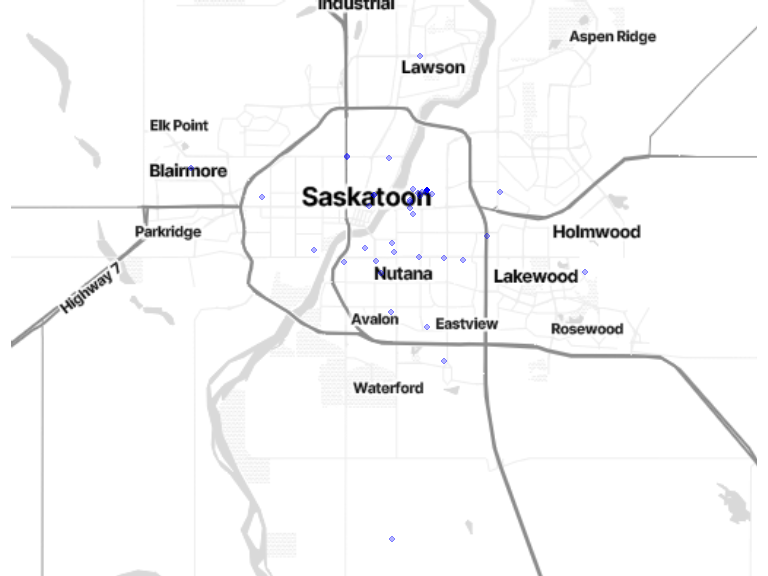
2.2.6 On average, how many hours per week do you study?
# histogram of n hours out
ggplot(data = veritas_main[veritas_main$studying == 1, ]) +
geom_histogram(aes(x = study_hours))
# Min, max, median & mean hours/day out
kable(t(as.matrix(summary(veritas_main$study_hours[veritas_main$studying == 1]))),
caption = "study hours/week",
digits = 1
) %>%
kable_styling(bootstrap_options = "striped", full_width = T, position = "left")| Min. | 1st Qu. | Median | Mean | 3rd Qu. | Max. |
|---|---|---|---|---|---|
| 4 | 15 | 30 | 29.1 | 40 | 70 |
2.3 Section 3: Shopping activities
The following questions are used to generate the locations grouped into this section:
- Do you shop for groceries at a supermarket at least once per month?
- Do you shop at a public/farmer’s market at least once per month?
- Do you shop at a bakery at least once per month?
- Do you go to a specialty food store at least once per month? For example: a cheese shop, fruit and vegetable store, butcher’s shop, natural and health food store.
- Do you go to a convenience store at least once per month?
- Do you go to a liquor store at least once per month?
shop_lut <- data.frame(
location_category_code = c(5, 6, 7, 8, 9, 10),
location_category = factor(c(
" 5 [Supermarket]",
" 6 [Public/farmer’s market]",
" 7 [Bakery]",
" 8 [Specialty food store]",
" 9 [Convenience store/Dépanneur]",
"10 [Liquor store/SAQ]"
))
)
shop_location <- locations[locations$location_category %in% shop_lut$location_category_code, ] %>%
dplyr::rename(location_category_code = location_category) %>%
inner_join(shop_lut, by = "location_category_code")
# map
bm + geom_sf(data = shop_location, inherit.aes = FALSE, aes(color = location_category), size = 1.5, alpha = .3) +
scale_color_brewer(palette = "Accent") +
theme(legend.position = "bottom", legend.text = element_text(size = 8), legend.title = element_blank())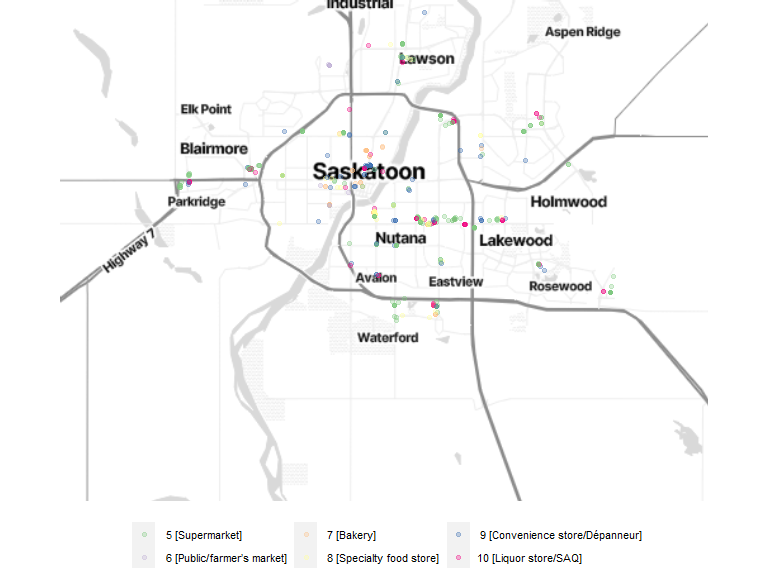
# compute number of shopping locations by category
ggplot(data = shop_location) +
geom_histogram(aes(x = location_category), stat = "count") +
scale_x_discrete(labels = function(lbl) str_wrap(lbl, width = 20)) +
labs(x = "Shopping locations by categories")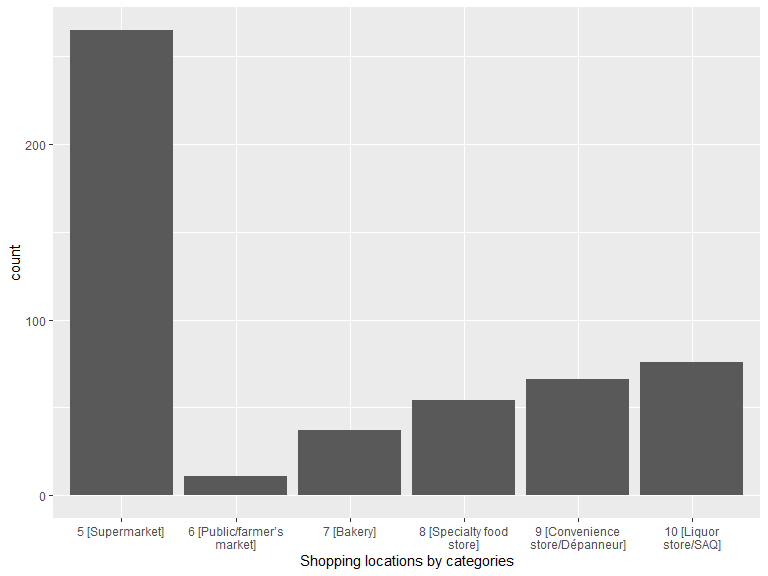
.location_category_cnt <- as.data.frame(shop_location[c("location_category")]) %>%
group_by(location_category) %>%
dplyr::count() %>%
arrange(location_category)
kable(.location_category_cnt, caption = "Shopping locations by categories") %>% kable_styling(bootstrap_options = "striped", full_width = T, position = "left")| location_category | n |
|---|---|
| 5 [Supermarket] | 265 |
| 6 [Public/farmer’s market] | 11 |
| 7 [Bakery] | 37 |
| 8 [Specialty food store] | 54 |
| 9 [Convenience store/Dépanneur] | 66 |
| 10 [Liquor store/SAQ] | 76 |
# compute statistics on shopping locations by participants and categories
# > one needs to account for participants who did not report location for some categories
.loc_iid_category_cnt <- as.data.frame(shop_location[c("interact_id", "location_category")]) %>%
group_by(interact_id, location_category) %>%
dplyr::count()
# (cont'd) simulate SQL JOIN TABLE ON TRUE to build list of all combination iid/shopping categ
.dummy <- data_frame(
interact_id = character(),
location_category = character()
)
for (iid in as.vector(veritas_main$interact_id)) {
.dmy <- data_frame(
interact_id = as.character(iid),
location_category = shop_lut$location_category
)
.dummy <- rbind(.dummy, .dmy)
}
# (cont'd) find iid/categ combination without match in veritas locations
.no_shop_iid <- dplyr::setdiff(.dummy, .loc_iid_category_cnt[c("location_category", "interact_id")]) %>%
mutate(n = 0)
.loc_iid_category_cnt <- bind_rows(.loc_iid_category_cnt, .no_shop_iid)
.location_category_cnt <- .loc_iid_category_cnt %>%
group_by(location_category) %>%
dplyr::summarise(min = min(n), mean = round(mean(n), 2), median = median(n), max = max(n)) %>%
arrange(location_category)
kable(.location_category_cnt, caption = "Number of shopping locations by participant and category") %>% kable_styling(bootstrap_options = "striped", full_width = T, position = "left")| location_category | min | mean | median | max |
|---|---|---|---|---|
| 5 [Supermarket] | 0 | 2.14 | 2 | 5 |
| 6 [Public/farmer’s market] | 0 | 0.09 | 0 | 2 |
| 7 [Bakery] | 0 | 0.30 | 0 | 4 |
| 8 [Specialty food store] | 0 | 0.44 | 0 | 4 |
| 9 [Convenience store/Dépanneur] | 0 | 0.53 | 0 | 4 |
| 10 [Liquor store/SAQ] | 0 | 0.61 | 0 | 4 |
2.4 Section 4: Services
The following questions are used to generate the locations grouped into this section:
- Where is the bank you go to most often located?
- Where is the hair salon or barber shop you go to most often?
- Where is the post office where you go to most often?
- Where is the drugstore you go to most often?
- If you need to visit a doctor or other healthcare provider, where do you go most often?
serv_lut <- data.frame(
location_category_code = c(11, 12, 13, 14, 15),
location_category = factor(c(
"11 [Bank]",
"12 [Hair salon/barbershop]",
"13 [Post office]",
"14 [Drugstore]",
"15 [Doctor/healthcare provider]"
))
)
serv_location <- locations[locations$location_category %in% serv_lut$location_category_code, ] %>%
dplyr::rename(location_category_code = location_category) %>%
inner_join(serv_lut, by = "location_category_code")
# map
bm + geom_sf(data = serv_location, inherit.aes = FALSE, aes(color = location_category), size = 1.5, alpha = .3) +
scale_color_brewer(palette = "Accent") +
theme(legend.position = "bottom", legend.text = element_text(size = 8), legend.title = element_blank())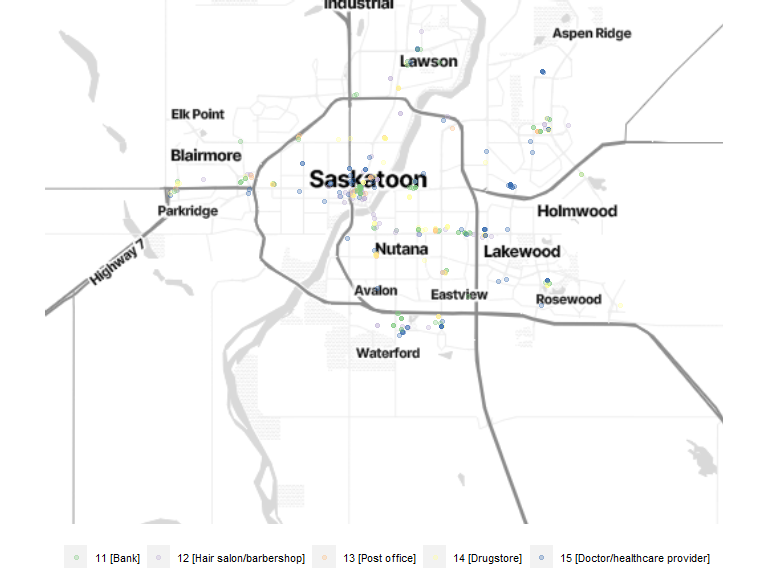
# compute number of shopping locations by category
ggplot(data = serv_location) +
geom_histogram(aes(x = location_category), stat = "count") +
scale_x_discrete(labels = function(lbl) str_wrap(lbl, width = 20)) +
labs(x = "Service locations by categories")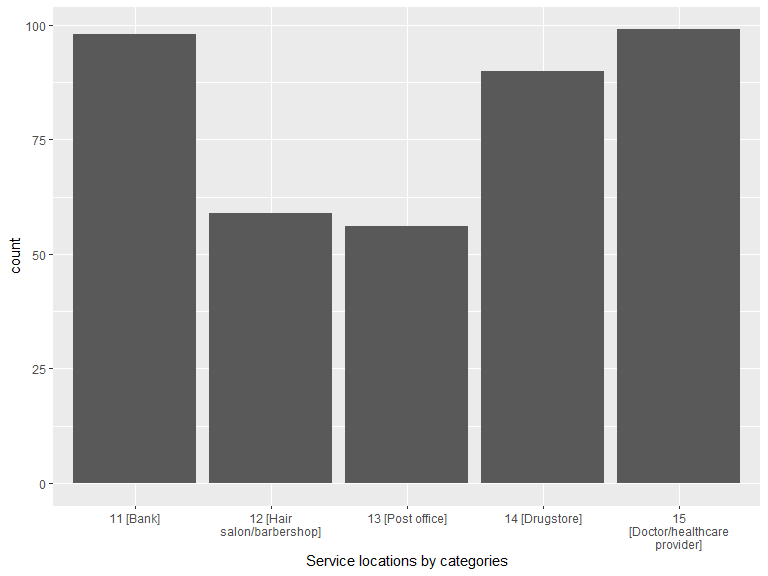
.location_category_cnt <- as.data.frame(serv_location[c("location_category")]) %>%
group_by(location_category) %>%
dplyr::count() %>%
arrange(location_category)
kable(.location_category_cnt, caption = "Shopping locations by categories") %>% kable_styling(bootstrap_options = "striped", full_width = T, position = "left")| location_category | n |
|---|---|
| 11 [Bank] | 98 |
| 12 [Hair salon/barbershop] | 59 |
| 13 [Post office] | 56 |
| 14 [Drugstore] | 90 |
| 15 [Doctor/healthcare provider] | 99 |
# compute statistics on shopping locations by participants and categories
# > one needs to account for participants who did not report location for some categories
.loc_iid_category_cnt <- as.data.frame(serv_location[c("interact_id", "location_category")]) %>%
group_by(interact_id, location_category) %>%
dplyr::count()
# (cont'd) simulate SQL JOIN TABLE ON TRUE
.dummy <- data_frame(
interact_id = character(),
location_category = character()
)
for (iid in as.vector(veritas_main$interact_id)) {
.dmy <- data_frame(
interact_id = as.character(iid),
location_category = serv_lut$location_category
)
.dummy <- rbind(.dummy, .dmy)
}
# (cont'd) find iid/categ combination without match in veritas locations
.no_serv_iid <- dplyr::setdiff(.dummy, .loc_iid_category_cnt[c("location_category", "interact_id")]) %>%
mutate(n = 0)
.loc_iid_category_cnt <- bind_rows(.loc_iid_category_cnt, .no_serv_iid)
.location_category_cnt <- .loc_iid_category_cnt %>%
group_by(location_category) %>%
dplyr::summarise(min = min(n), mean = round(mean(n), 2), median = median(n), max = max(n)) %>%
arrange(location_category)
kable(.location_category_cnt, caption = "Number of shopping locations by participant and category") %>% kable_styling(bootstrap_options = "striped", full_width = T, position = "left")| location_category | min | mean | median | max |
|---|---|---|---|---|
| 11 [Bank] | 0 | 0.79 | 1 | 1 |
| 12 [Hair salon/barbershop] | 0 | 0.48 | 0 | 1 |
| 13 [Post office] | 0 | 0.45 | 0 | 1 |
| 14 [Drugstore] | 0 | 0.73 | 1 | 1 |
| 15 [Doctor/healthcare provider] | 0 | 0.80 | 1 | 5 |
2.5 Section 5: Transportation
2.5.1 Do you use public transit from your home?
# extract and recode
.transp <- veritas_main[c("interact_id", "public_transit")] %>% dplyr::rename(public_transit_code = public_transit)
.transp$public_transit <- factor(ifelse(.transp$public_transit_code == 1, "1 [Yes]",
ifelse(.transp$public_transit_code == 2, "2 [No]", "N/A")
))
# histogram of answers
ggplot(data = .transp) +
geom_histogram(aes(x = public_transit), stat = "count") +
scale_x_discrete(labels = function(lbl) str_wrap(lbl, width = 20)) +
labs(x = "public_transit")
.transp_cnt <- .transp %>%
group_by(public_transit) %>%
dplyr::count() %>%
arrange(public_transit)
kable(.transp_cnt, caption = "Use public transit") %>% kable_styling(bootstrap_options = "striped", full_width = T, position = "left")| public_transit | n |
|---|---|
| 1 [Yes] | 62 |
| 2 [No] | 62 |
2.5.2 Where are the public transit stops that you access from your home?
transp_location <- locations[locations$location_category == 16, ]
bm + geom_sf(data = transp_location, inherit.aes = FALSE, color = "blue", size = 1.8, alpha = .3)
2.6 Section 6: Leisure activities
The following questions are used to generate the locations grouped into this section:
- Do you participate in any (individual or group) sports or leisure-time physical activities at least once per month?
- Do you visit a park at least once per month?
- Do you participate in or attend as a spectator a cultural or non-sport leisure activity at least once per month? For example: singing or drawing lessons, book or poker club, concert or play.
- Do you volunteer at least once per month?
- Do you engage in any religious or spiritual activities at least once per month?
- Do you go to a restaurant, café, bar or other food and drink establishment at least once per month?
- Do you get take-out food at least once per month?
- Do you regularly go for walks?
leisure_lut <- data.frame(
location_category_code = c(17, 18, 19, 20, 21, 22, 23, 24),
location_category = factor(c(
"17 [Leisure-time physical activity]",
"18 [Park]",
"19 [Cultural activity]",
"20 [Volunteering place]",
"21 [Religious or spiritual activity]",
"22 [Restaurant, café, bar, etc. ]",
"23 [Take-out]",
"24 [Walk]"
))
)
leisure_location <- locations[locations$location_category %in% leisure_lut$location_category_code, ] %>%
dplyr::rename(location_category_code = location_category) %>%
inner_join(leisure_lut, by = "location_category_code")
# map
bm + geom_sf(data = leisure_location, inherit.aes = FALSE, aes(color = location_category), size = 1.5, alpha = .3) +
scale_color_brewer(palette = "Accent") +
theme(legend.position = "bottom", legend.text = element_text(size = 8), legend.title = element_blank())
# compute number of shopping locations by category
ggplot(data = leisure_location) +
geom_histogram(aes(x = location_category), stat = "count") +
scale_x_discrete(labels = function(lbl) str_wrap(lbl, width = 20)) +
labs(x = "Leisure locations by categories")
.location_category_cnt <- as.data.frame(leisure_location[c("location_category")]) %>%
group_by(location_category) %>%
dplyr::count() %>%
arrange(location_category)
kable(.location_category_cnt, caption = "Shopping locations by categories") %>% kable_styling(bootstrap_options = "striped", full_width = T, position = "left")| location_category | n |
|---|---|
| 17 [Leisure-time physical activity] | 76 |
| 18 [Park] | 112 |
| 19 [Cultural activity] | 1 |
| 20 [Volunteering place] | 15 |
| 21 [Religious or spiritual activity] | 11 |
| 22 [Restaurant, café, bar, etc. ] | 123 |
| 23 [Take-out] | 151 |
| 24 [Walk] | 131 |
# compute statistics on shopping locations by participants and categories
# > one needs to account for participants who did not report location for some categories
.loc_iid_category_cnt <- as.data.frame(leisure_location[c("interact_id", "location_category")]) %>%
group_by(interact_id, location_category) %>%
dplyr::count()
# (cont'd) simulate SQL JOIN TABLE ON TRUE
.dummy <- data_frame(
interact_id = character(),
location_category = character()
)
for (iid in as.vector(veritas_main$interact_id)) {
.dmy <- data_frame(
interact_id = as.character(iid),
location_category = leisure_lut$location_category
)
.dummy <- rbind(.dummy, .dmy)
}
# (cont'd) find iid/categ combination without match in veritas locations
.no_leisure_iid <- dplyr::setdiff(.dummy, .loc_iid_category_cnt[c("location_category", "interact_id")]) %>%
mutate(n = 0)
.loc_iid_category_cnt <- bind_rows(.loc_iid_category_cnt, .no_leisure_iid)
.location_category_cnt <- .loc_iid_category_cnt %>%
group_by(location_category) %>%
dplyr::summarise(min = min(n), mean = round(mean(n), 2), median = median(n), max = max(n)) %>%
arrange(location_category)
kable(.location_category_cnt, caption = "Number of leisure locations by participant and category") %>% kable_styling(bootstrap_options = "striped", full_width = T, position = "left")| location_category | min | mean | median | max |
|---|---|---|---|---|
| 17 [Leisure-time physical activity] | 0 | 0.61 | 0 | 5 |
| 18 [Park] | 0 | 0.90 | 1 | 5 |
| 19 [Cultural activity] | 0 | 0.01 | 0 | 1 |
| 20 [Volunteering place] | 0 | 0.12 | 0 | 1 |
| 21 [Religious or spiritual activity] | 0 | 0.09 | 0 | 3 |
| 22 [Restaurant, café, bar, etc. ] | 0 | 0.99 | 1 | 5 |
| 23 [Take-out] | 0 | 1.22 | 1 | 5 |
| 24 [Walk] | 0 | 1.06 | 1 | 5 |
2.7 Section 7: Other places/activities
2.7.1 Are there other places that you go to at least once per month that we have not mentioned? For example: a mall, a daycare, a hardware store, or a community center.
# extract and recode
.other <- veritas_main[c("interact_id", "other")] %>% dplyr::rename(other_code = other)
.other$other <- factor(ifelse(.other$other_code == 1, "1 [Yes]",
ifelse(.other$other_code == 2, "2 [No]", "N/A")
))
# histogram of answers
ggplot(data = .other) +
geom_histogram(aes(x = other), stat = "count") +
scale_x_discrete(labels = function(lbl) str_wrap(lbl, width = 20)) +
labs(x = "other")
.other_cnt <- .other %>%
group_by(other) %>%
dplyr::count() %>%
arrange(other)
kable(.other_cnt, caption = "Other places") %>% kable_styling(bootstrap_options = "striped", full_width = T, position = "left")| other | n |
|---|---|
| 1 [Yes] | 24 |
| 2 [No] | 100 |
2.7.2 Can you locate this place?
other_location <- locations[locations$location_category == 25, ]
bm + geom_sf(data = other_location, inherit.aes = FALSE, color = "blue", size = 1.8, alpha = .3)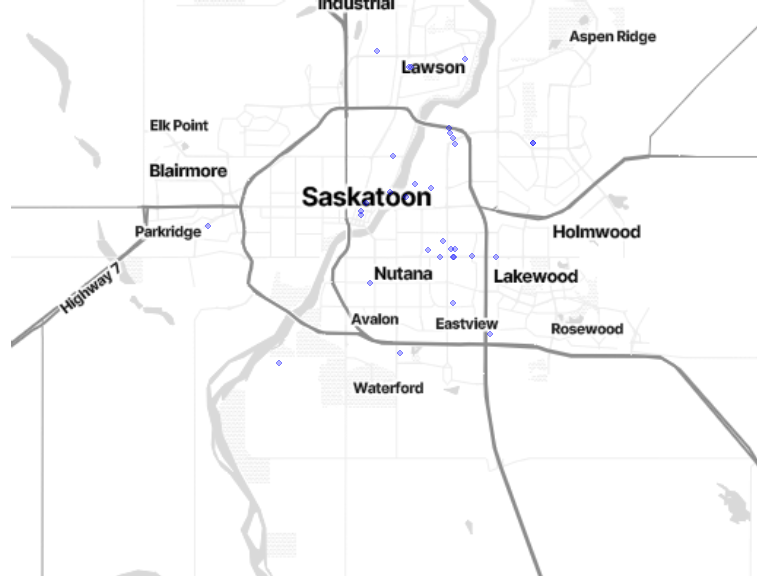
2.8 Section 8: Areas of change
2.8.1 Can you locate areas where you have noticed an improvement of the urban environment?
# extract and recode
.improv <- veritas_main[c("interact_id", "improvement_none")] %>% dplyr::rename(improvement_none_code = improvement_none)
.improv$improvement_none <- factor(ifelse(.improv$improvement_none_code == 1, "1 [TRUE]",
ifelse(.improv$improvement_none_code == 0, "0 [FALSE]", "N/A")
))
# histogram of answers
ggplot(data = .improv) +
geom_histogram(aes(x = improvement_none), stat = "count") +
scale_x_discrete(labels = function(lbl) str_wrap(lbl, width = 20)) +
labs(x = "improvement_none")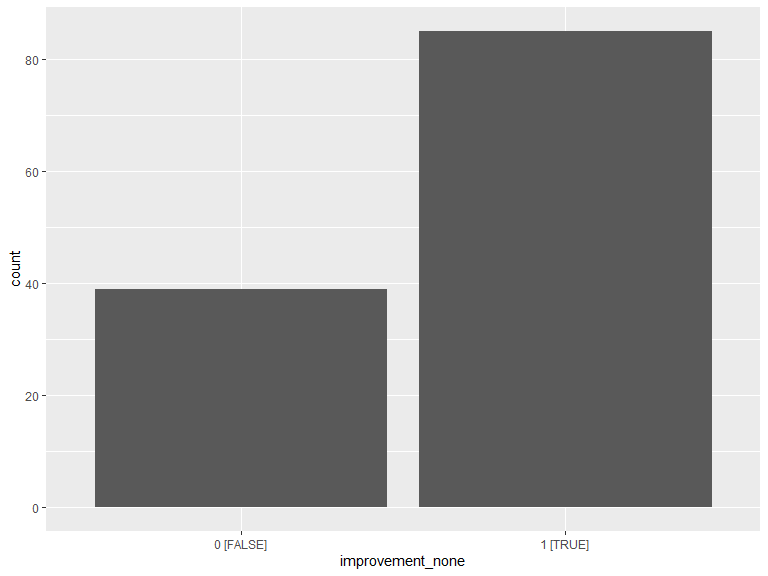
.improv_cnt <- .improv %>%
group_by(improvement_none) %>%
dplyr::count() %>%
arrange(improvement_none)
kable(.improv_cnt, caption = "No area of improvement") %>% kable_styling(bootstrap_options = "striped", full_width = T, position = "left")| improvement_none | n |
|---|---|
| 0 [FALSE] | 39 |
| 1 [TRUE] | 85 |
# polgon extraction
improv <- poly_geom[poly_geom$area_type == "improvement", ]
# Map
bm + geom_sf(data = improv, inherit.aes = FALSE, fill = alpha("blue", 0.3), color = alpha("blue", 0.5))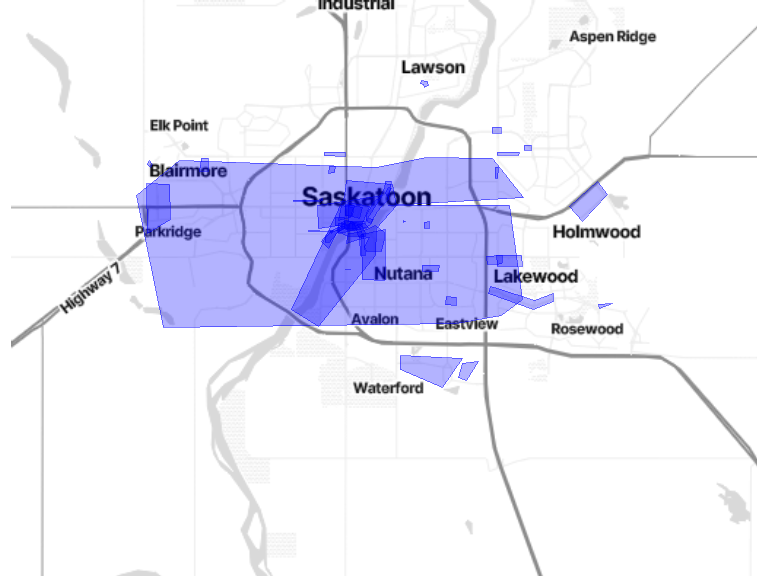
# Min, max, median & mean area of PRN
improv <- improv %>%
mutate(area_m2 = st_area(.))
kable(t(as.matrix(summary(improv$area_m2))),
caption = "Area (in square meters) of the perceived improvement areas",
digits = 1
) %>% kable_styling(bootstrap_options = "striped", full_width = T, position = "left")| Min. | 1st Qu. | Median | Mean | 3rd Qu. | Max. |
|---|---|---|---|---|---|
| 2095.9 | 62440 | 154360.2 | 2227609 | 526253.1 | 60269942 |
2.8.2 Can you locate areas where you have noticed a deterioration of the urban environment?
# extract and recode
.deter <- veritas_main[c("interact_id", "deterioration_none")] %>% dplyr::rename(deterioration_none_code = deterioration_none)
.deter$deterioration_none <- factor(ifelse(.deter$deterioration_none_code == 1, "1 [TRUE]",
ifelse(.deter$deterioration_none_code == 0, "0 [FALSE]", "N/A")
))
# histogram of answers
ggplot(data = .deter) +
geom_histogram(aes(x = deterioration_none), stat = "count") +
scale_x_discrete(labels = function(lbl) str_wrap(lbl, width = 20)) +
labs(x = "deterioration_none")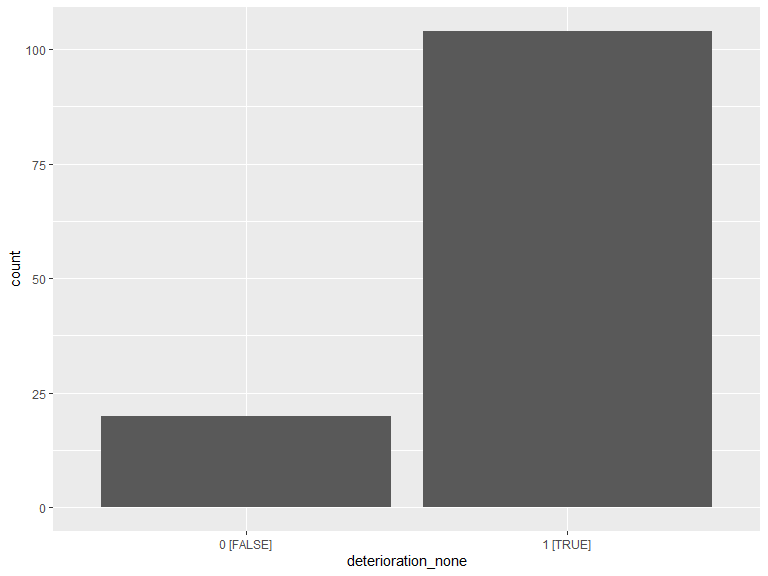
.deter_cnt <- .deter %>%
group_by(deterioration_none) %>%
dplyr::count() %>%
arrange(deterioration_none)
kable(.deter_cnt, caption = "No area of deterioration") %>% kable_styling(bootstrap_options = "striped", full_width = T, position = "left")| deterioration_none | n |
|---|---|
| 0 [FALSE] | 20 |
| 1 [TRUE] | 104 |
# polgon extraction
deter <- poly_geom[poly_geom$area_type == "deterioration", ]
# Map
bm + geom_sf(data = deter, inherit.aes = FALSE, fill = alpha("blue", 0.3), color = alpha("blue", 0.5))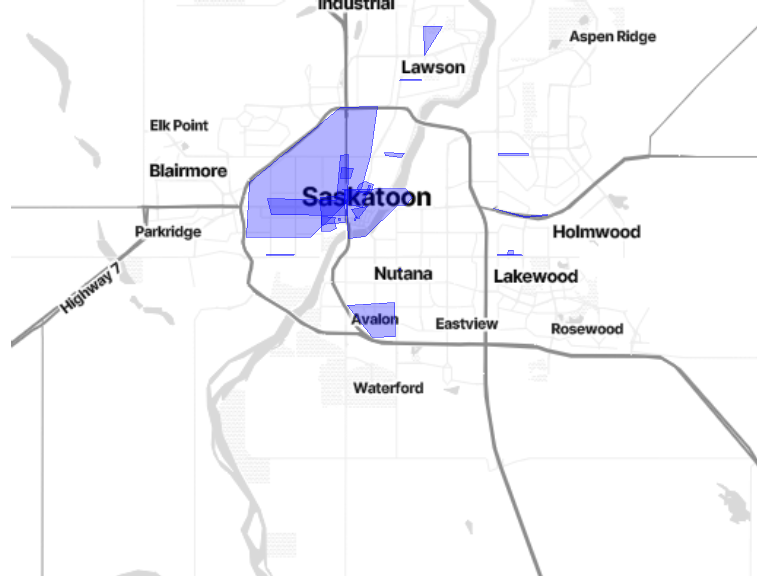
# Min, max, median & mean area of PRN
deter <- deter %>%
mutate(area_m2 = st_area(.))
kable(t(as.matrix(summary(deter$area_m2))),
caption = "Area (in square meters) of the perceived deterioration areas",
digits = 1
) %>%
kable_styling(bootstrap_options = "striped", full_width = T, position = "left")| Min. | 1st Qu. | Median | Mean | 3rd Qu. | Max. |
|---|---|---|---|---|---|
| 2885.9 | 46555.9 | 142753.1 | 962796.2 | 491679.5 | 11126015 |
2.10 Derived metrics
2.10.1 Existence of improvement and deterioration areas by participant
Combination of improvement and/or deterioration areas per participant
# cross tab of improvement vs deteriation areas
.improv <- improv[c("interact_id")] %>%
mutate(improv = "Improvement")
.deter <- deter[c("interact_id")] %>%
mutate(deter = "Deterioration")
.ct_impr_deter <- veritas_main[c("interact_id")] %>%
transmute(interact_id = as.character(interact_id)) %>%
left_join(.improv, by = "interact_id") %>%
left_join(.deter, by = "interact_id") %>%
mutate_all(~ replace(., is.na(.), "N/A"))
kable(table(.ct_impr_deter$improv, .ct_impr_deter$deter), caption = "Improvement vs. deterioration") %>%
kable_styling(bootstrap_options = "striped", full_width = T, position = "left", row_label_position = "r") %>%
column_spec(1, bold = T)| Deterioration | N/A | |
|---|---|---|
| Improvement | 14 | 21 |
| N/A | 5 | 84 |
2.10.2 Transportation mode preferences
Based on the answers to the question Usually, how do you go there? (Check all that apply.).
# code en
# 1 By car and you drive
# 2 By car and someone else drives
# 3 By taxi/Uber
# 4 On foot
# 5 By bike
# 6 By bus
# 7 By subway
# 8 By train
# 99 Other
loc_labels <- data.frame(location_category = c(2:26), description = c(
" 2 [Other residence]",
" 3 [Work]",
" 4 [School/College/University]",
" 5 [Supermarket]",
" 6 [Public/farmer’s market]",
" 7 [Bakery]",
" 8 [Specialty food store]",
" 9 [Convenience store/Dépanneur]",
"10 [Liquor store/SAQ]",
"11 [Bank]",
"12 [Hair salon/barbershop]",
"13 [Post office]",
"14 [Drugstore]",
"15 [Doctor/healthcare provider]",
"16 [Public transit stop]",
"17 [Leisure-time physical activity]",
"18 [Park]",
"19 [Cultural activity]",
"20 [Volunteering place]",
"21 [Religious/spiritual activity]",
"22 [Restaurant, café, bar, etc.]",
"23 [Take-out]",
"24 [Walk]",
"25 [Other place]",
"26 [Social contact residence]"
))
# extract and summary stats
.tm <- locations %>%
st_set_geometry(NULL) %>%
filter(location_category != 1) %>%
left_join(loc_labels)
.tm_grouped <- .tm %>%
group_by(description) %>%
dplyr::summarise(
N = n(), "By car (driver)" = sum(location_tmode_1),
"By car (passenger)" = sum(location_tmode_2),
"By taxi/Uber" = sum(location_tmode_3),
"On foot" = sum(location_tmode_4),
"By bike" = sum(location_tmode_5),
"By bus" = sum(location_tmode_6),
"By train" = sum(location_tmode_7),
"Other" = sum(location_tmode_99)
)
kable(.tm_grouped, caption = "Transportation mode preferences") %>% kable_styling(bootstrap_options = "striped", full_width = T, position = "left")| description | N | By car (driver) | By car (passenger) | By taxi/Uber | On foot | By bike | By bus | By train | Other |
|---|---|---|---|---|---|---|---|---|---|
| 2 [Other residence] | 19 | 7 | 8 | 0 | 3 | 1 | 7 | 0 | 1 |
| 3 [Work] | 94 | 36 | 10 | 4 | 22 | 8 | 23 | 0 | 22 |
| 4 [School/College/University] | 48 | 9 | 5 | 0 | 16 | 1 | 11 | 0 | 20 |
| 5 [Supermarket] | 265 | 155 | 46 | 0 | 77 | 10 | 40 | 0 | 2 |
| 6 [Public/farmer’s market] | 11 | 8 | 2 | 0 | 2 | 1 | 2 | 0 | 0 |
| 7 [Bakery] | 37 | 15 | 7 | 0 | 19 | 1 | 2 | 0 | 0 |
| 8 [Specialty food store] | 54 | 29 | 8 | 1 | 24 | 1 | 4 | 0 | 0 |
| 9 [Convenience store/Dépanneur] | 66 | 16 | 7 | 0 | 45 | 2 | 9 | 0 | 1 |
| 10 [Liquor store/SAQ] | 76 | 46 | 11 | 0 | 23 | 1 | 6 | 0 | 0 |
| 11 [Bank] | 98 | 51 | 5 | 1 | 38 | 4 | 17 | 0 | 1 |
| 12 [Hair salon/barbershop] | 59 | 37 | 5 | 1 | 14 | 5 | 11 | 0 | 0 |
| 13 [Post office] | 56 | 25 | 1 | 0 | 31 | 3 | 9 | 0 | 1 |
| 14 [Drugstore] | 90 | 46 | 9 | 0 | 46 | 4 | 14 | 0 | 0 |
| 15 [Doctor/healthcare provider] | 99 | 56 | 9 | 8 | 14 | 6 | 29 | 0 | 4 |
| 16 [Public transit stop] | 108 | 2 | 1 | 1 | 76 | 0 | 37 | 0 | 0 |
| 17 [Leisure-time physical activity] | 76 | 40 | 15 | 0 | 15 | 12 | 2 | 0 | 7 |
| 18 [Park] | 112 | 30 | 12 | 0 | 74 | 4 | 3 | 0 | 1 |
| 19 [Cultural activity] | 1 | 0 | 1 | 0 | 1 | 0 | 0 | 0 | 0 |
| 20 [Volunteering place] | 15 | 6 | 1 | 0 | 5 | 0 | 3 | 0 | 4 |
| 21 [Religious/spiritual activity] | 11 | 3 | 1 | 0 | 4 | 0 | 0 | 0 | 3 |
| 22 [Restaurant, café, bar, etc.] | 123 | 60 | 33 | 5 | 44 | 4 | 17 | 0 | 0 |
| 23 [Take-out] | 151 | 57 | 28 | 1 | 20 | 1 | 10 | 0 | 44 |
| 24 [Walk] | 131 | 16 | 3 | 1 | 111 | 3 | 6 | 0 | 4 |
| 25 [Other place] | 34 | 23 | 2 | 2 | 5 | 2 | 3 | 0 | 1 |
# graph
.tm1 <- .tm %>%
filter(location_tmode_1 == 1) %>%
mutate(tm = "[1] By car (driver)")
.tm2 <- .tm %>%
filter(location_tmode_2 == 1) %>%
mutate(tm = "[2] By car (passenger)")
.tm3 <- .tm %>%
filter(location_tmode_3 == 1) %>%
mutate(tm = "[3] By taxi/Uber")
.tm4 <- .tm %>%
filter(location_tmode_4 == 1) %>%
mutate(tm = "[4] On foot")
.tm5 <- .tm %>%
filter(location_tmode_5 == 1) %>%
mutate(tm = "[5] By bike")
.tm6 <- .tm %>%
filter(location_tmode_6 == 1) %>%
mutate(tm = "[6] By bus")
# .tm7 <- .tm %>% # Empty dataframe -> error when creating tm col.
# filter(location_tmode_7 == 1) %>%
# mutate(tm = "[7] By train")
.tm99 <- .tm %>%
filter(location_tmode_99 == 1) %>%
mutate(tm = "[99] Other")
.tm <- bind_rows(.tm1, .tm2) %>%
bind_rows(.tm3) %>%
bind_rows(.tm4) %>%
bind_rows(.tm5) %>%
bind_rows(.tm6) %>%
# bind_rows(.tm7) %>%
bind_rows(.tm99)
# histogram of answers
ggplot(data = .tm) +
geom_bar(aes(x = fct_rev(description), fill = tm), position = "fill") +
scale_fill_brewer(palette = "Set3", name = "Transport modes") +
scale_y_continuous(labels = percent) +
labs(y = "Proportion of transportation mode by location category", x = element_blank()) +
coord_flip() +
theme(legend.position = "bottom", legend.justification = c(0, 0), legend.text = element_text(size = 8)) +
guides(fill = guide_legend(nrow = 3))
2.10.3 Visiting places alone
Based on the answers to the question Do you usually go to this place alone or with other people?.
loc_labels <- data.frame(location_category = c(2:26), description = c(
" 2 [Other residence]",
" 3 [Work]",
" 4 [School/College/University]",
" 5 [Supermarket]",
" 6 [Public/farmer’s market]",
" 7 [Bakery]",
" 8 [Specialty food store]",
" 9 [Convenience store/Dépanneur]",
"10 [Liquor store/SAQ]",
"11 [Bank]",
"12 [Hair salon/barbershop]",
"13 [Post office]",
"14 [Drugstore]",
"15 [Doctor/healthcare provider]",
"16 [Public transit stop]",
"17 [Leisure-time physical activity]",
"18 [Park]",
"19 [Cultural activity]",
"20 [Volunteering place]",
"21 [Religious/spiritual activity]",
"22 [Restaurant, café, bar, etc.]",
"23 [Take-out]",
"24 [Walk]",
"25 [Other place]",
"26 [Social contact residence]"
))
# extract and summary stats
.alone <- locations %>%
st_set_geometry(NULL) %>%
filter(location_category != 1) %>%
left_join(loc_labels) %>%
mutate(location_alone_recode = case_when(
location_alone2 == 1 ~ 1,
location_alone2 == 2 ~ 0
))
.alone_grouped <- .alone %>%
group_by(description) %>%
dplyr::summarise(
N = n(), "Visited alone" = sum(location_alone_recode),
"Visited alone (%)" = round(sum(location_alone_recode) * 100.0 / n(), digits = 1)
)
kable(.alone_grouped, caption = "Visiting places alone") %>% kable_styling(bootstrap_options = "striped", full_width = T, position = "left")| description | N | Visited alone | Visited alone (%) |
|---|---|---|---|
| 2 [Other residence] | 19 | 1 | 5.3 |
| 3 [Work] | 94 | 39 | 41.5 |
| 4 [School/College/University] | 48 | 34 | 70.8 |
| 5 [Supermarket] | 265 | 200 | 75.5 |
| 6 [Public/farmer’s market] | 11 | 7 | 63.6 |
| 7 [Bakery] | 37 | 22 | 59.5 |
| 8 [Specialty food store] | 54 | 36 | 66.7 |
| 9 [Convenience store/Dépanneur] | 66 | 49 | 74.2 |
| 10 [Liquor store/SAQ] | 76 | 51 | 67.1 |
| 11 [Bank] | 98 | 90 | 91.8 |
| 12 [Hair salon/barbershop] | 59 | 56 | 94.9 |
| 13 [Post office] | 56 | 50 | 89.3 |
| 14 [Drugstore] | 90 | 78 | 86.7 |
| 15 [Doctor/healthcare provider] | 99 | 84 | 84.8 |
| 16 [Public transit stop] | 108 | 96 | 88.9 |
| 17 [Leisure-time physical activity] | 76 | 37 | 48.7 |
| 18 [Park] | 112 | 55 | 49.1 |
| 19 [Cultural activity] | 1 | 0 | 0.0 |
| 20 [Volunteering place] | 15 | 8 | 53.3 |
| 21 [Religious/spiritual activity] | 11 | 4 | 36.4 |
| 22 [Restaurant, café, bar, etc.] | 123 | 43 | 35.0 |
| 23 [Take-out] | 151 | 76 | 50.3 |
| 24 [Walk] | 131 | 94 | 71.8 |
| 25 [Other place] | 34 | 20 | 58.8 |
# histogram of answers
ggplot(data = .alone) +
geom_bar(aes(x = fct_rev(description), fill = factor(location_alone2)), position = "fill") +
scale_fill_brewer(palette = "Set3", name = "Visiting places", labels = c("Alone", "With someone")) +
scale_y_continuous(labels = percent) +
labs(y = "Proportion of places visited alone", x = element_blank()) +
coord_flip()
2.10.4 Visit frequency
Based on the answers to the question How often do you go there?.
loc_labels <- data.frame(location_category = c(2:26), description = c(
" 2 [Other residence]",
" 3 [Work]",
" 4 [School/College/University]",
" 5 [Supermarket]",
" 6 [Public/farmer’s market]",
" 7 [Bakery]",
" 8 [Specialty food store]",
" 9 [Convenience store/Dépanneur]",
"10 [Liquor store/SAQ]",
"11 [Bank]",
"12 [Hair salon/barbershop]",
"13 [Post office]",
"14 [Drugstore]",
"15 [Doctor/healthcare provider]",
"16 [Public transit stop]",
"17 [Leisure-time physical activity]",
"18 [Park]",
"19 [Cultural activity]",
"20 [Volunteering place]",
"21 [Religious/spiritual activity]",
"22 [Restaurant, café, bar, etc.]",
"23 [Take-out]",
"24 [Walk]",
"25 [Other place]",
"26 [Social contact residence]"
))
# extract and summary stats
.freq <- locations %>%
st_set_geometry(NULL) %>%
filter(location_category != 1) %>%
left_join(loc_labels)
.freq_grouped <- .freq %>%
group_by(description) %>%
dplyr::summarise(
N = n(), min = min(location_freq_visit),
max = max(location_freq_visit),
mean = mean(location_freq_visit),
median = median(location_freq_visit),
sd = sd(location_freq_visit)
)
kable(.freq_grouped, caption = "Visit frequency (expressed in times/year)") %>% kable_styling(bootstrap_options = "striped", full_width = T, position = "left")| description | N | min | max | mean | median | sd |
|---|---|---|---|---|---|---|
| 2 [Other residence] | 19 | 1 | 520 | 120 | 104 | 125.471765 |
| 3 [Work] | 94 | 0 | 5200 | 289 | 260 | 527.252580 |
| 4 [School/College/University] | 48 | 0 | 5200 | 340 | 312 | 730.791700 |
| 5 [Supermarket] | 265 | 0 | 520 | 44 | 24 | 51.185853 |
| 6 [Public/farmer’s market] | 11 | 5 | 104 | 30 | 12 | 36.903560 |
| 7 [Bakery] | 37 | 3 | 104 | 31 | 12 | 30.099410 |
| 8 [Specialty food store] | 54 | 1 | 104 | 17 | 12 | 19.101343 |
| 9 [Convenience store/Dépanneur] | 66 | 1 | 364 | 63 | 36 | 72.367698 |
| 10 [Liquor store/SAQ] | 76 | 1 | 156 | 20 | 12 | 21.986583 |
| 11 [Bank] | 98 | 0 | 104 | 12 | 12 | 15.582146 |
| 12 [Hair salon/barbershop] | 59 | 0 | 312 | 11 | 4 | 40.489661 |
| 13 [Post office] | 56 | 0 | 52 | 12 | 6 | 14.179908 |
| 14 [Drugstore] | 90 | 1 | 260 | 23 | 12 | 35.305870 |
| 15 [Doctor/healthcare provider] | 99 | 0 | 60 | 5 | 3 | 9.094377 |
| 16 [Public transit stop] | 108 | 2 | 520 | 112 | 52 | 123.768743 |
| 17 [Leisure-time physical activity] | 76 | 1 | 5200 | 172 | 52 | 592.713557 |
| 18 [Park] | 112 | 1 | 728 | 76 | 48 | 107.139440 |
| 19 [Cultural activity] | 1 | 1 | 1 | 1 | 1 | NA |
| 20 [Volunteering place] | 15 | 1 | 52000 | 3498 | 24 | 13417.481594 |
| 21 [Religious/spiritual activity] | 11 | 1 | 5200 | 590 | 52 | 1536.676420 |
| 22 [Restaurant, café, bar, etc.] | 123 | 1 | 264 | 26 | 12 | 34.766056 |
| 23 [Take-out] | 151 | 0 | 208 | 22 | 12 | 31.706350 |
| 24 [Walk] | 131 | 1 | 884 | 110 | 52 | 143.860672 |
| 25 [Other place] | 34 | 1 | 624 | 49 | 12 | 112.843289 |
# graph
ggplot(data = .freq) +
geom_boxplot(aes(x = fct_rev(description), y = location_freq_visit)) +
scale_y_continuous(limits = c(0, 365)) +
labs(y = "Visits/year (Frequency over 1 visit/day not shown)", x = element_blank()) +
coord_flip()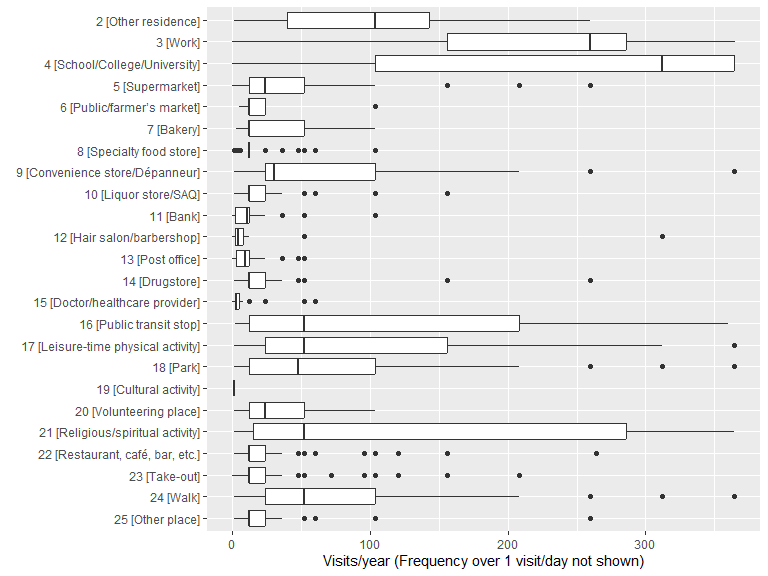
2.10.5 Spatial indicators: Camille Perchoux’s toolbox
Below is a list of indicators proposed by Camille Perchoux in her paper Assessing patterns of spatial behavior in health studies: Their socio-demographic determinants and associations with transportation modes (the RECORD Cohort Study).
-- Reading Camille tbx indics from Essence table
SELECT interact_id,
n_acti_places, n_weekly_vst, n_acti_types,
cvx_perimeter, cvx_surface,
min_length, max_length, median_length,
pct_visits_neighb,
n_acti_prn, pct_visits_prn, prn_area_km2
FROM essence_table.essence_perchoux_tbx
WHERE city_id = 'Saskatoon' AND wave_id = 2 AND status = 'new'3 Basic descriptive statistics for returning participants
3.1 Section 1: Residence and Neighbourhood
3.1.1 Now, let’s start with your home. What is your address?
home_location <- locations[locations$location_category == 1, ]
## version ggmap
skt_aoi <- st_bbox(home_location)
names(skt_aoi) <- c("left", "bottom", "right", "top")
skt_aoi[["left"]] <- skt_aoi[["left"]] - .07
skt_aoi[["right"]] <- skt_aoi[["right"]] + .07
skt_aoi[["top"]] <- skt_aoi[["top"]] + .01
skt_aoi[["bottom"]] <- skt_aoi[["bottom"]] - .01
bm <- get_stadiamap(skt_aoi, zoom = 11, maptype = "stamen_toner_lite") %>%
ggmap(extent = "device")
bm + geom_sf(data = st_jitter(home_location, .008), inherit.aes = FALSE, color = "blue", size = 1.8, alpha = .3) # see https://github.com/r-spatial/sf/issues/336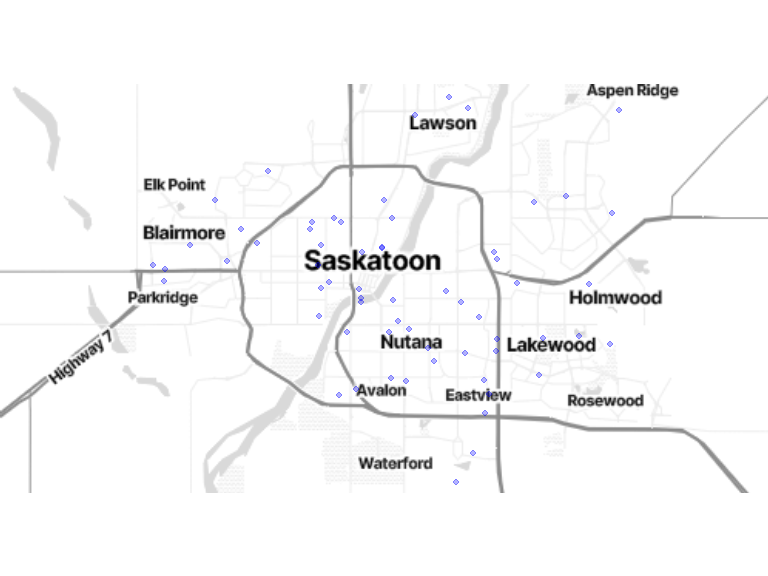
NB: Home locations have been randomly shifted from their original position to protect privacy.
# Number of participants by municipalites
home_by_municipalites <- st_join(home_location, municipalities["NAME"])
home_by_mun_cnt <- as.data.frame(home_by_municipalites) %>%
group_by(NAME) %>%
dplyr::count() %>%
arrange(desc(n), NAME)
home_by_mun_cnt$Shape <- NULL
kable(home_by_mun_cnt, caption = "Number of participants by municipalities") %>% kable_styling(bootstrap_options = "striped", full_width = T, position = "left")| NAME | n |
|---|---|
| Saskatoon | 63 |
3.1.2 If you were asked to draw the boundaries of your neighbourhood, what would they be?
prn <- poly_geom[poly_geom$area_type == "neighborhood", ]
## version ggmap
bm + geom_sf(data = prn, inherit.aes = FALSE, fill = alpha("blue", 0.05), color = alpha("blue", 0.3))
# Min, max, median & mean area of PRN
prn$area_m2 <- st_area(prn$geom)
kable(t(as.matrix(summary(prn$area_m2))),
caption = "Area (in square meters) of the perceived residential neighborhood",
digits = 1
) %>%
kable_styling(bootstrap_options = "striped", full_width = T, position = "left")| Min. | 1st Qu. | Median | Mean | 3rd Qu. | Max. |
|---|---|---|---|---|---|
| 7007.5 | 588305.4 | 1092275 | 1400642 | 1948467 | 5287563 |
NB only 60 valid neighborhoods were collected, as many participants struggled to draw polygons on the map.
3.1.3 How attached are you to your neighbourhood?
# extract and recode
.ngh_att <- veritas_main[veritas_main$neighbourhood_attach != 99, c("interact_id", "neighbourhood_attach")] %>% dplyr::rename(neighbourhood_attach_code = neighbourhood_attach)
.ngh_att$neighbourhood_attach <- factor(ifelse(.ngh_att$neighbourhood_attach_code == 1, "1 [Not attached at all]",
ifelse(.ngh_att$neighbourhood_attach_code == 6, "6 [Very attached]",
.ngh_att$neighbourhood_attach_code
)
))
# histogram of attachment
ggplot(data = .ngh_att) +
geom_histogram(aes(x = neighbourhood_attach), stat = "count") +
scale_x_discrete(labels = function(lbl) str_wrap(lbl, width = 20)) +
labs(x = "neighbourhood_attach")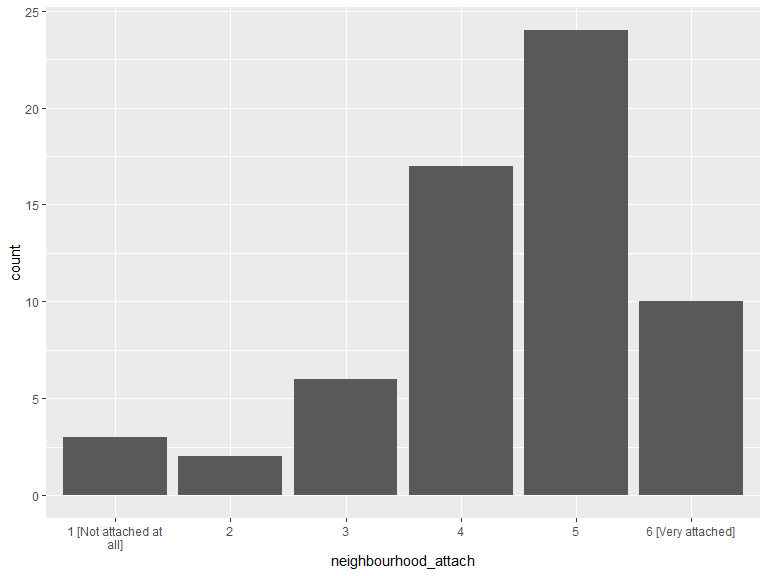
.ngh_att_cnt <- .ngh_att %>%
group_by(neighbourhood_attach) %>%
dplyr::count() %>%
arrange(neighbourhood_attach)
kable(.ngh_att_cnt, caption = "Neigbourhood attachment") %>%
kable_styling(bootstrap_options = "striped", full_width = T, position = "left")| neighbourhood_attach | n |
|---|---|
| 1 [Not attached at all] | 3 |
| 2 | 2 |
| 3 | 6 |
| 4 | 17 |
| 5 | 24 |
| 6 [Very attached] | 10 |
3.1.4 On average, how many hours per day do you spend outside of your home?
# histogram of n hours out
ggplot(data = veritas_main) +
geom_histogram(aes(x = hours_out))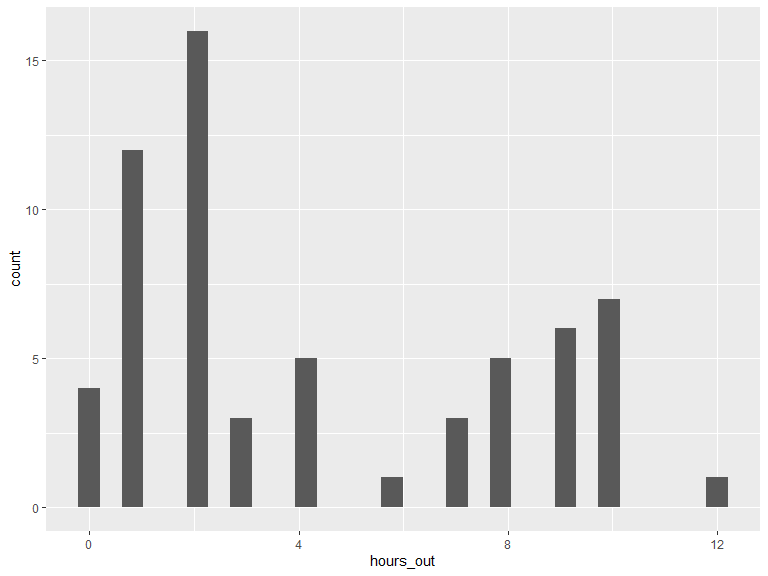
# Min, max, median & mean hours/day out
kable(t(as.matrix(summary(veritas_main$hours_out))),
caption = "Hours/day outside home",
digits = 1
) %>%
kable_styling(bootstrap_options = "striped", full_width = T, position = "left")| Min. | 1st Qu. | Median | Mean | 3rd Qu. | Max. |
|---|---|---|---|---|---|
| 0 | 1.5 | 2 | 4.4 | 8 | 12 |
3.1.5 Of this time spent outside your home, on average how many hours do you spend outside your neighbourhood?
# histogram of n hours out
ggplot(data = veritas_main) +
geom_histogram(aes(x = hours_out_neighb))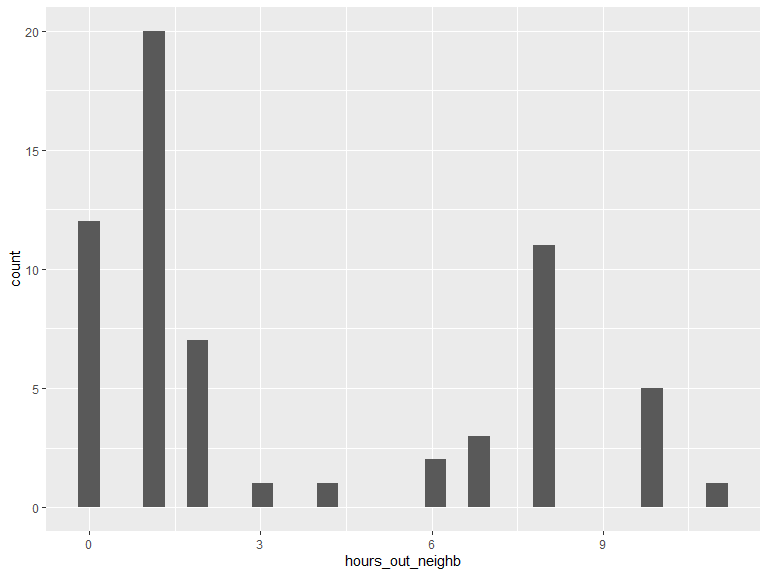
# Min, max, median & mean hours/day out of neighborhood
kable(t(as.matrix(summary(veritas_main$hours_out_neighb))),
caption = "Hours/day outside neighbourhood",
digits = 1
) %>%
kable_styling(bootstrap_options = "striped", full_width = T, position = "left")| Min. | 1st Qu. | Median | Mean | 3rd Qu. | Max. |
|---|---|---|---|---|---|
| 0 | 1 | 1 | 3.5 | 8 | 11 |
3.1.6 Are there one or more areas close to where you live that you tend to avoid because you do not feel safe there (for any reason)?
# extract and recode
.unsafe <- veritas_main[c("interact_id", "unsafe_area")] %>% dplyr::rename(unsafe_area_code = unsafe_area)
.unsafe$unsafe_area <- factor(ifelse(.unsafe$unsafe_area_code == 1, "1 [Yes]",
ifelse(.unsafe$unsafe_area_code == 2, "2 [No]", "N/A")
))
# histogram of answers
ggplot(data = .unsafe) +
geom_histogram(aes(x = unsafe_area), stat = "count") +
scale_x_discrete(labels = function(lbl) str_wrap(lbl, width = 20)) +
labs(x = "unsafe_area")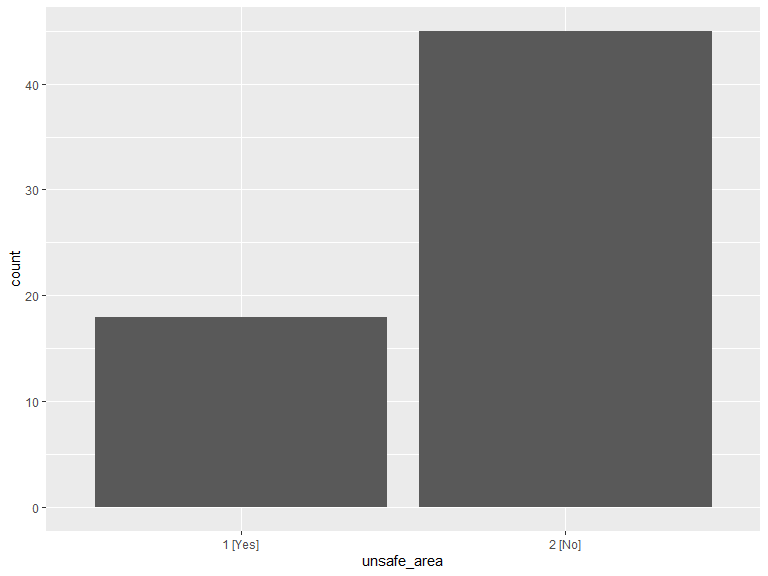
.unsafe_cnt <- .unsafe %>%
group_by(unsafe_area) %>%
dplyr::count() %>%
arrange(unsafe_area)
kable(.unsafe_cnt, caption = "Unsafe areas") %>%
kable_styling(bootstrap_options = "striped", full_width = T, position = "left")| unsafe_area | n |
|---|---|
| 1 [Yes] | 18 |
| 2 [No] | 45 |
# map
unsafe <- poly_geom[poly_geom$area_type == "unsafe area", ]
## version ggmap
bm + geom_sf(data = unsafe, inherit.aes = FALSE, fill = alpha("blue", 0.3), color = alpha("blue", 0.5))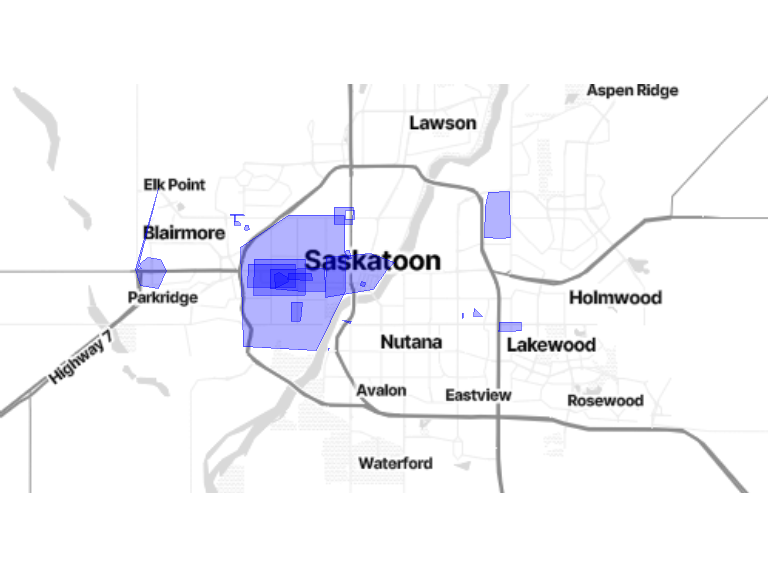
# Min, max, median & mean area of PRN
unsafe$area_m2 <- st_area(unsafe$geom)
kable(t(as.matrix(summary(unsafe$area_m2))),
caption = "Area (in square meters) of the perceived unsafe area",
digits = 1
) %>%
kable_styling(bootstrap_options = "striped", full_width = T, position = "left")| Min. | 1st Qu. | Median | Mean | 3rd Qu. | Max. |
|---|---|---|---|---|---|
| 1301.4 | 42224.1 | 181229.3 | 1106828 | 1032925 | 11301512 |
3.1.7 Do you spend the night somewhere other than your home at least once per week?
# extract and recode
.o_res <- veritas_main[c("interact_id", "other_resid")] %>% dplyr::rename(other_resid_code = other_resid)
.o_res$other_resid <- factor(ifelse(.o_res$other_resid_code == 1, "1 [Yes]",
ifelse(.o_res$other_resid_code == 2, "2 [No]", "N/A")
))
# histogram of answers
ggplot(data = .o_res) +
geom_histogram(aes(x = other_resid), stat = "count") +
scale_x_discrete(labels = function(lbl) str_wrap(lbl, width = 20)) +
labs(x = "other_resid")
.o_res_cnt <- .o_res %>%
group_by(other_resid) %>%
dplyr::count() %>%
arrange(other_resid)
kable(.o_res_cnt, caption = "Other residence") %>%
kable_styling(bootstrap_options = "striped", full_width = T, position = "left")| other_resid | n |
|---|---|
| 1 [Yes] | 5 |
| 2 [No] | 58 |
3.2 Section 2: Occupation
3.2.1 Are you currently working?
# extract and recode
.work <- veritas_main[c("interact_id", "working")] %>% dplyr::rename(working_code = working)
.work$working <- factor(ifelse(.work$working_code == 1, "1 [Yes]",
ifelse(.work$working_code == 2, "2 [No]", "N/A")
))
# histogram of answers
ggplot(data = .work) +
geom_histogram(aes(x = working), stat = "count") +
scale_x_discrete(labels = function(lbl) str_wrap(lbl, width = 20)) +
labs(x = "working")
.work_cnt <- .work %>%
group_by(working) %>%
dplyr::count() %>%
arrange(working)
kable(.work_cnt, caption = "Currently working") %>%
kable_styling(bootstrap_options = "striped", full_width = T, position = "left")| working | n |
|---|---|
| 1 [Yes] | 45 |
| 2 [No] | 18 |
3.2.2 Where do you work?
work_location <- locations[locations$location_category == 3, ]
bm + geom_sf(data = work_location, inherit.aes = FALSE, color = "blue", size = 1.8, alpha = .3)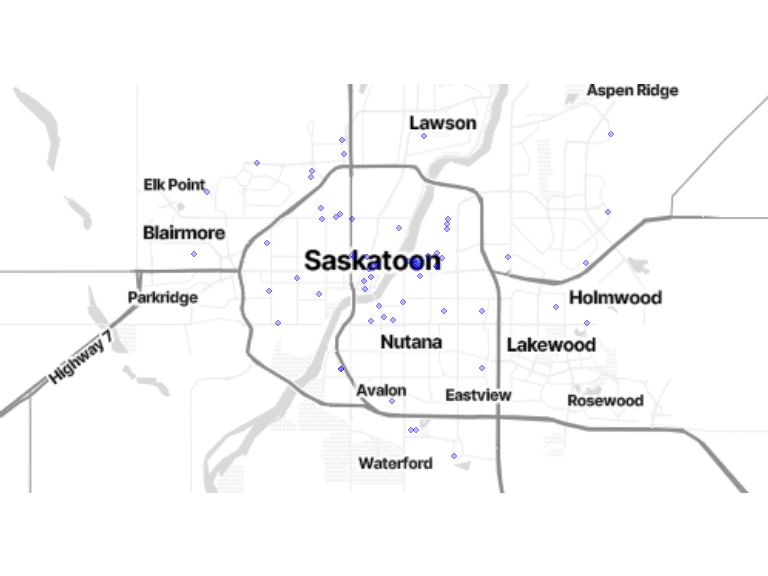
3.2.3 On average, how many hours per week do you work?
# histogram of n hours out
ggplot(data = veritas_main[veritas_main$working == 1, ]) +
geom_histogram(aes(x = work_hours))
# Min, max, median & mean hours/day out
kable(t(as.matrix(summary(veritas_main$work_hours[veritas_main$working == 1]))),
caption = "Work hours/week",
digits = 1
) %>%
kable_styling(bootstrap_options = "striped", full_width = T, position = "left")| Min. | 1st Qu. | Median | Mean | 3rd Qu. | Max. |
|---|---|---|---|---|---|
| 0 | 35 | 38 | 37.3 | 40 | 60 |
3.2.4 Are you currently a registered student?
# extract and recode
.study <- veritas_main[c("interact_id", "studying")] %>% dplyr::rename(studying_code = studying)
.study$studying <- factor(ifelse(.study$studying_code == 1, "1 [Yes]",
ifelse(.study$studying_code == 2, "2 [No]", "N/A")
))
# histogram of answers
ggplot(data = .study) +
geom_histogram(aes(x = studying), stat = "count") +
scale_x_discrete(labels = function(lbl) str_wrap(lbl, width = 20)) +
labs(x = "Studying")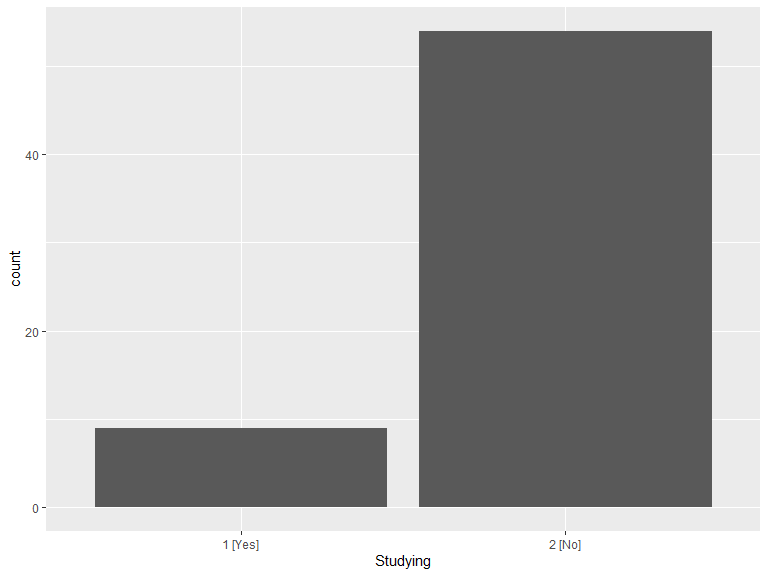
.study_cnt <- .study %>%
group_by(studying) %>%
dplyr::count() %>%
arrange(studying)
kable(.study_cnt, caption = "Currently studying") %>% kable_styling(bootstrap_options = "striped", full_width = T, position = "left")| studying | n |
|---|---|
| 1 [Yes] | 9 |
| 2 [No] | 54 |
3.2.5 Where do you study?
study_location <- locations[locations$location_category == 4, ]
bm + geom_sf(data = study_location, inherit.aes = FALSE, color = "blue", size = 1.8, alpha = .3)
3.2.6 On average, how many hours per week do you study?
# histogram of n hours out
ggplot(data = veritas_main[veritas_main$studying == 1, ]) +
geom_histogram(aes(x = study_hours))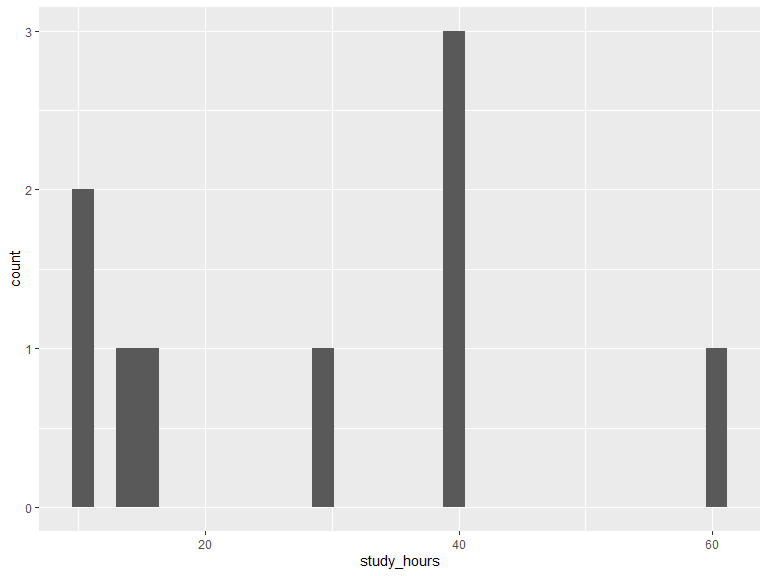
# Min, max, median & mean hours/day out
kable(t(as.matrix(summary(veritas_main$study_hours[veritas_main$studying == 1]))),
caption = "study hours/week",
digits = 1
) %>%
kable_styling(bootstrap_options = "striped", full_width = T, position = "left")| Min. | 1st Qu. | Median | Mean | 3rd Qu. | Max. |
|---|---|---|---|---|---|
| 10 | 14 | 30 | 28.8 | 40 | 60 |
3.3 Section 3: Shopping activities
3.3.1 In Date of Previous Data Collection Wave, you reported shopping at these locations. Do you still visit these places?
shop_lut <- data.frame(
location_category_code = c(5, 6, 7, 8, 9, 10),
location_category = factor(c(
" 5 [Supermarket]",
" 6 [Public/farmer’s market]",
" 7 [Bakery]",
" 8 [Specialty food store]",
" 9 [Convenience store/Dépanneur]",
"10 [Liquor store/SAQ]"
))
)
shop_location <- locations[locations$location_category %in% shop_lut$location_category_code, ] %>%
filter(location_current == 1) %>%
dplyr::rename(location_category_code = location_category) %>%
inner_join(shop_lut, by = "location_category_code")
# map
bm + geom_sf(data = shop_location, inherit.aes = FALSE, aes(color = location_category), size = 1.5, alpha = .3) +
scale_color_brewer(palette = "Accent") +
theme(legend.position = "bottom", legend.text = element_text(size = 8), legend.title = element_blank())
# compute number of shopping locations by category
ggplot(data = shop_location) +
geom_histogram(aes(x = location_category), stat = "count") +
scale_x_discrete(labels = function(lbl) str_wrap(lbl, width = 20)) +
labs(x = "Shopping locations by categories")
.location_category_cnt <- as.data.frame(shop_location[c("location_category")]) %>%
group_by(location_category) %>%
dplyr::count() %>%
arrange(location_category)
kable(.location_category_cnt, caption = "Shopping locations by categories") %>% kable_styling(bootstrap_options = "striped", full_width = T, position = "left")| location_category | n |
|---|---|
| 5 [Supermarket] | 155 |
| 6 [Public/farmer’s market] | 5 |
| 7 [Bakery] | 14 |
| 8 [Specialty food store] | 29 |
| 9 [Convenience store/Dépanneur] | 18 |
| 10 [Liquor store/SAQ] | 25 |
# compute statistics on shopping locations by participants and categories
# > one needs to account for participants who did not report location for some categories
.loc_iid_category_cnt <- as.data.frame(shop_location[c("interact_id", "location_category")]) %>%
group_by(interact_id, location_category) %>%
dplyr::count()
# (cont'd) simulate SQL JOIN TABLE ON TRUE to build list of all combination iid/shopping categ
.dummy <- data_frame(
interact_id = character(),
location_category = character()
)
for (iid in as.vector(veritas_main$interact_id)) {
.dmy <- data_frame(
interact_id = as.character(iid),
location_category = shop_lut$location_category
)
.dummy <- rbind(.dummy, .dmy)
}
# (cont'd) find iid/categ combination without match in veritas locations
.no_shop_iid <- dplyr::setdiff(.dummy, .loc_iid_category_cnt[c("location_category", "interact_id")]) %>%
mutate(n = 0)
.loc_iid_category_cnt <- bind_rows(.loc_iid_category_cnt, .no_shop_iid)
.location_category_cnt <- .loc_iid_category_cnt %>%
group_by(location_category) %>%
dplyr::summarise(min = min(n), mean = round(mean(n), 2), median = median(n), max = max(n)) %>%
arrange(location_category)
kable(.location_category_cnt, caption = "Number of shopping locations by participant and category") %>% kable_styling(bootstrap_options = "striped", full_width = T, position = "left")| location_category | min | mean | median | max |
|---|---|---|---|---|
| 5 [Supermarket] | 0 | 2.46 | 2 | 5 |
| 6 [Public/farmer’s market] | 0 | 0.08 | 0 | 1 |
| 7 [Bakery] | 0 | 0.22 | 0 | 4 |
| 8 [Specialty food store] | 0 | 0.46 | 0 | 3 |
| 9 [Convenience store/Dépanneur] | 0 | 0.29 | 0 | 4 |
| 10 [Liquor store/SAQ] | 0 | 0.40 | 0 | 3 |
3.3.2 Thinking about the places where you shop, are there other supermarkets, farmers markets, bakeries, specialty stores, convenience stores or liquor stores you visit at least once per month?
# extract and recode
.grp_shopping <- veritas_main[c("interact_id", "grp_shopping_new")] %>% dplyr::rename(grp_shopping_new_code = grp_shopping_new)
.grp_shopping$grp_shopping_new <- factor(ifelse(.grp_shopping$grp_shopping_new_code == 1, "1 [Yes]",
ifelse(.grp_shopping$grp_shopping_new_code == 2, "2 [No]", "N/A")
))
# histogram of answers
ggplot(data = .grp_shopping) +
geom_histogram(aes(x = grp_shopping_new), stat = "count") +
scale_x_discrete(labels = function(lbl) str_wrap(lbl, width = 20)) +
labs(x = "grp_shopping_new")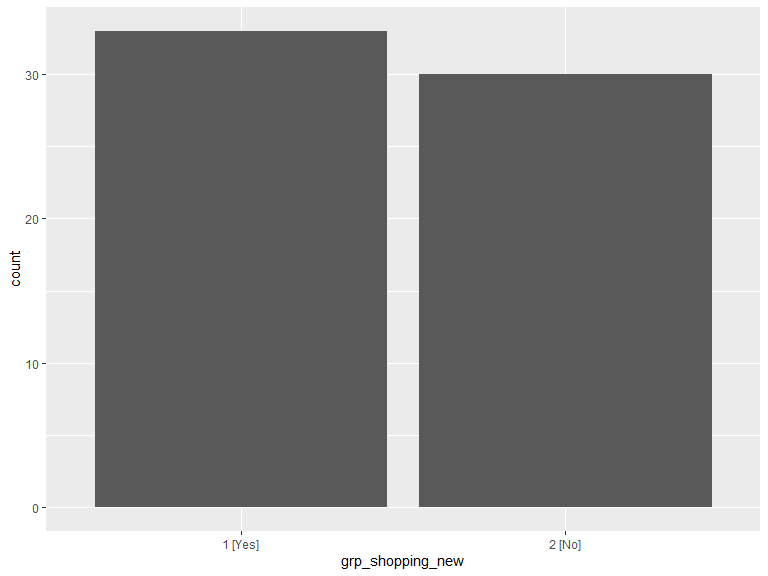
.grp_shopping_cnt <- .grp_shopping %>%
group_by(grp_shopping_new) %>%
dplyr::count() %>%
arrange(grp_shopping_new)
kable(.grp_shopping_cnt, caption = "New shopping places") %>% kable_styling(bootstrap_options = "striped", full_width = T, position = "left")| grp_shopping_new | n |
|---|---|
| 1 [Yes] | 33 |
| 2 [No] | 30 |
3.4 Section 4: Services
3.4.1 In Date of Previous Data Collection Wave, you reported using services at these locations. Do you still visit these places?
serv_lut <- data.frame(
location_category_code = c(11, 12, 13, 14, 15),
location_category = factor(c(
"11 [Bank]",
"12 [Hair salon/barbershop]",
"13 [Post office]",
"14 [Drugstore]",
"15 Doctor/healthcare provider]"
))
)
serv_location <- locations[locations$location_category %in% serv_lut$location_category_code, ] %>%
filter(location_current == 1) %>%
dplyr::rename(location_category_code = location_category) %>%
inner_join(serv_lut, by = "location_category_code")
# map
bm + geom_sf(data = serv_location, inherit.aes = FALSE, aes(color = location_category), size = 1.5, alpha = .3) +
scale_color_brewer(palette = "Accent") +
theme(legend.position = "bottom", legend.text = element_text(size = 8), legend.title = element_blank())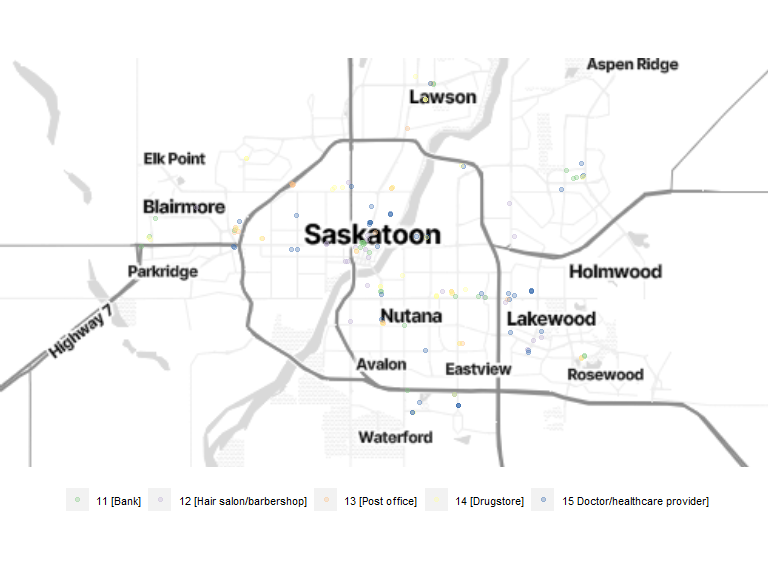
# compute number of shopping locations by category
ggplot(data = serv_location) +
geom_histogram(aes(x = location_category), stat = "count") +
scale_x_discrete(labels = function(lbl) str_wrap(lbl, width = 20)) +
labs(x = "Service locations by categories")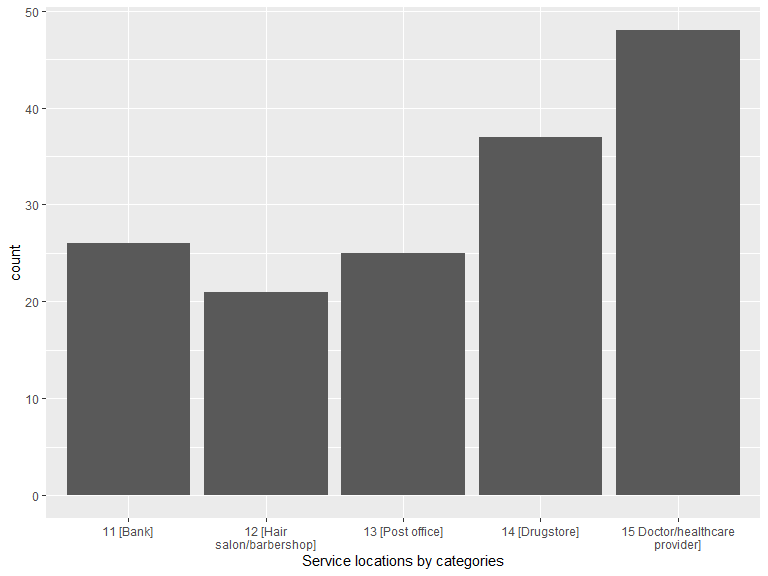
.location_category_cnt <- as.data.frame(serv_location[c("location_category")]) %>%
group_by(location_category) %>%
dplyr::count() %>%
arrange(location_category)
kable(.location_category_cnt, caption = "Shopping locations by categories") %>% kable_styling(bootstrap_options = "striped", full_width = T, position = "left")| location_category | n |
|---|---|
| 11 [Bank] | 26 |
| 12 [Hair salon/barbershop] | 21 |
| 13 [Post office] | 25 |
| 14 [Drugstore] | 37 |
| 15 Doctor/healthcare provider] | 48 |
# compute statistics on shopping locations by participants and categories
# > one needs to account for participants who did not report location for some categories
.loc_iid_category_cnt <- as.data.frame(serv_location[c("interact_id", "location_category")]) %>%
group_by(interact_id, location_category) %>%
dplyr::count()
# (cont'd) simulate SQL JOIN TABLE ON TRUE
.dummy <- data_frame(
interact_id = character(),
location_category = character()
)
for (iid in as.vector(veritas_main$interact_id)) {
.dmy <- data_frame(
interact_id = as.character(iid),
location_category = serv_lut$location_category
)
.dummy <- rbind(.dummy, .dmy)
}
# (cont'd) find iid/categ combination without match in veritas locations
.no_serv_iid <- dplyr::setdiff(.dummy, .loc_iid_category_cnt[c("location_category", "interact_id")]) %>%
mutate(n = 0)
.loc_iid_category_cnt <- bind_rows(.loc_iid_category_cnt, .no_serv_iid)
.location_category_cnt <- .loc_iid_category_cnt %>%
group_by(location_category) %>%
dplyr::summarise(min = min(n), mean = round(mean(n), 2), median = median(n), max = max(n)) %>%
arrange(location_category)
kable(.location_category_cnt, caption = "Number of shopping locations by participant and category") %>% kable_styling(bootstrap_options = "striped", full_width = T, position = "left")| location_category | min | mean | median | max |
|---|---|---|---|---|
| 11 [Bank] | 0 | 0.41 | 0 | 1 |
| 12 [Hair salon/barbershop] | 0 | 0.33 | 0 | 1 |
| 13 [Post office] | 0 | 0.40 | 0 | 1 |
| 14 [Drugstore] | 0 | 0.59 | 1 | 1 |
| 15 Doctor/healthcare provider] | 0 | 0.76 | 1 | 4 |
3.4.2 Thinking about the places where you use services, are there other banks, hair salons, post offices, drugstores, doctors or other healthcare providers you visit at least once per month?
NB: Variable grp_services_new has not been
properly recorded in Saskatoon wave 2 for returning participants.
# extract and recode
.grp_services <- veritas_main[c("interact_id", "grp_services_new")] %>% dplyr::rename(grp_services_new_code = grp_services_new)
.grp_services$grp_services_new <- factor(ifelse(.grp_services$grp_services_new_code == 1, "1 [Yes]",
ifelse(.grp_services$grp_services_new_code == 2, "2 [No]", "N/A")
))
# histogram of answers
ggplot(data = .grp_services) +
geom_histogram(aes(x = grp_services_new), stat = "count") +
scale_x_discrete(labels = function(lbl) str_wrap(lbl, width = 20)) +
labs(x = "grp_services_new")
.grp_services_cnt <- .grp_services %>%
group_by(grp_services_new) %>%
dplyr::count() %>%
arrange(grp_services_new)
kable(.grp_services_cnt, caption = "New services places") %>% kable_styling(bootstrap_options = "striped", full_width = T, position = "left")3.5 Section 5: Transportation
3.5.1 In Date of Previous Data Collection Wave, you reported accessing these public transit stops from your home. Do you still access these places?
transp_location <- locations[locations$location_category == 16, ] %>% filter(location_current == 1)
bm + geom_sf(data = transp_location, inherit.aes = FALSE, color = "blue", size = 1.8, alpha = .3)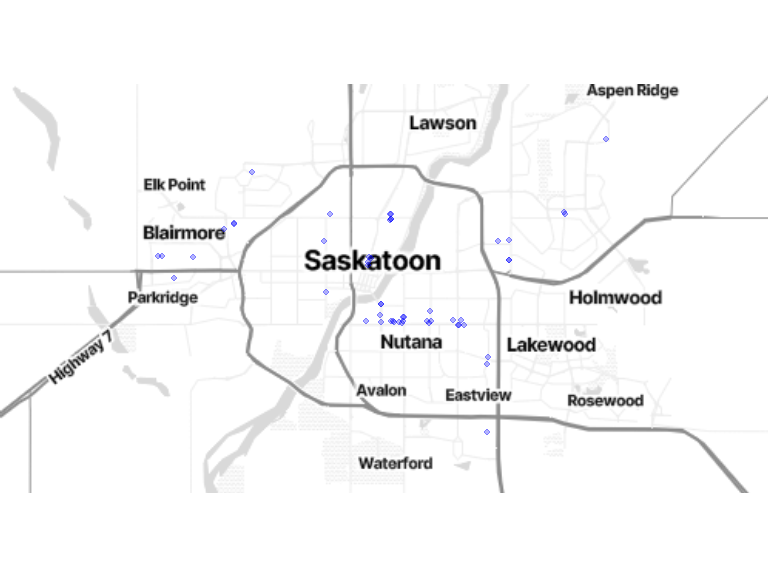
3.5.2 Are there other public transit stops you access from your home at least once per month?
NB: Variable grp_ptransit_new has not been
properly recorded in Saskatoon wave 2 for returning participants.
# extract and recode
.grp_ptransit <- veritas_main[c("interact_id", "grp_ptransit_new")] %>% dplyr::rename(grp_ptransit_new_code = grp_ptransit_new)
.grp_ptransit$grp_ptransit_new <- factor(ifelse(.grp_ptransit$grp_ptransit_new_code == 1, "1 [Yes]",
ifelse(.grp_ptransit$grp_ptransit_new_code == 2, "2 [No]", "N/A")
))
# histogram of answers
ggplot(data = .grp_ptransit) +
geom_histogram(aes(x = grp_ptransit_new), stat = "count") +
scale_x_discrete(labels = function(lbl) str_wrap(lbl, width = 20)) +
labs(x = "grp_ptransit_new")
.grp_ptransit_cnt <- .grp_ptransit %>%
group_by(grp_ptransit_new) %>%
dplyr::count() %>%
arrange(grp_ptransit_new)
kable(.grp_ptransit_cnt, caption = "New transit places") %>% kable_styling(bootstrap_options = "striped", full_width = T, position = "left")3.6 Section 6: Leisure activities
3.6.1 In Date of Previous Data Collection Wave, you reported doing leisure activities at these locations. Do you still visit these places?
leisure_lut <- data.frame(
location_category_code = c(17, 18, 19, 20, 21, 22, 23, 24),
location_category = factor(c(
"17 [Leisure-time physical activity]",
"18 [Park]",
"19 [Cultural activity]",
"20 [Volunteering place]",
"21 [Religious or spiritual activity]",
"22 [Restaurant, café, bar, etc. ]",
"23 [Take-out]",
"24 [Walk]"
))
)
leisure_location <- locations[locations$location_category %in% leisure_lut$location_category_code, ] %>%
dplyr::rename(location_category_code = location_category) %>%
inner_join(leisure_lut, by = "location_category_code")
# map
bm + geom_sf(data = leisure_location, inherit.aes = FALSE, aes(color = location_category), size = 1.5, alpha = .3) +
scale_color_brewer(palette = "Accent") +
theme(legend.position = "bottom", legend.text = element_text(size = 8), legend.title = element_blank())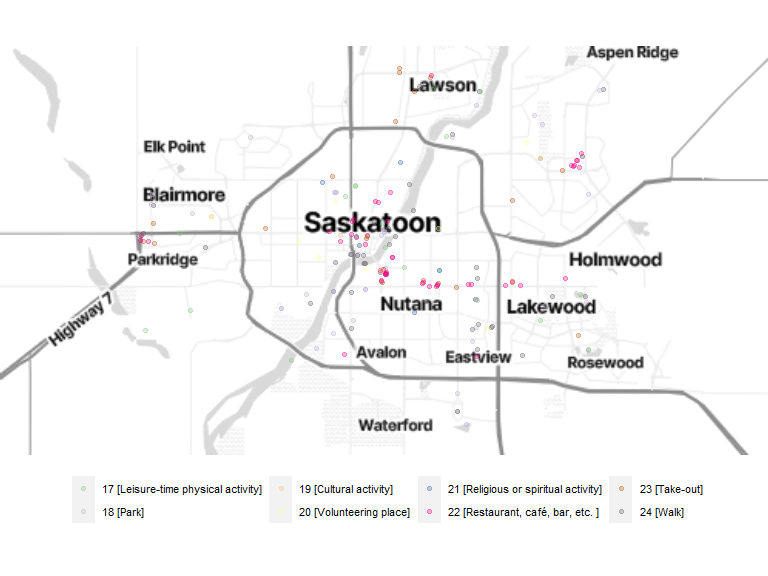
# compute number of shopping locations by category
ggplot(data = leisure_location) +
geom_histogram(aes(x = location_category), stat = "count") +
scale_x_discrete(labels = function(lbl) str_wrap(lbl, width = 20)) +
labs(x = "Leisure locations by categories")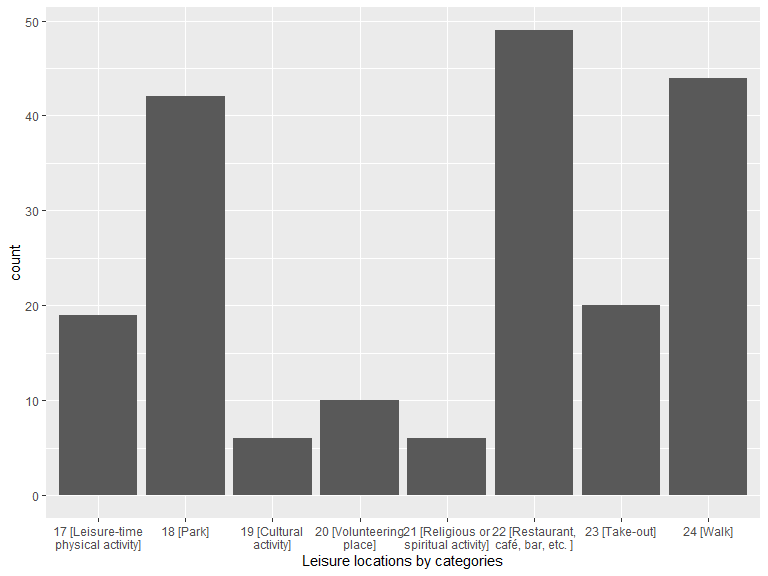
.location_category_cnt <- as.data.frame(leisure_location[c("location_category")]) %>%
group_by(location_category) %>%
dplyr::count() %>%
arrange(location_category)
kable(.location_category_cnt, caption = "Shopping locations by categories") %>% kable_styling(bootstrap_options = "striped", full_width = T, position = "left")| location_category | n |
|---|---|
| 17 [Leisure-time physical activity] | 19 |
| 18 [Park] | 42 |
| 19 [Cultural activity] | 6 |
| 20 [Volunteering place] | 10 |
| 21 [Religious or spiritual activity] | 6 |
| 22 [Restaurant, café, bar, etc. ] | 49 |
| 23 [Take-out] | 20 |
| 24 [Walk] | 44 |
# compute statistics on shopping locations by participants and categories
# > one needs to account for participants who did not report location for some categories
.loc_iid_category_cnt <- as.data.frame(leisure_location[c("interact_id", "location_category")]) %>%
group_by(interact_id, location_category) %>%
dplyr::count()
# (cont'd) simulate SQL JOIN TABLE ON TRUE
.dummy <- data_frame(
interact_id = character(),
location_category = character()
)
for (iid in as.vector(veritas_main$interact_id)) {
.dmy <- data_frame(
interact_id = as.character(iid),
location_category = leisure_lut$location_category
)
.dummy <- rbind(.dummy, .dmy)
}
# (cont'd) find iid/categ combination without match in veritas locations
.no_leisure_iid <- dplyr::setdiff(.dummy, .loc_iid_category_cnt[c("location_category", "interact_id")]) %>%
mutate(n = 0)
.loc_iid_category_cnt <- bind_rows(.loc_iid_category_cnt, .no_leisure_iid)
.location_category_cnt <- .loc_iid_category_cnt %>%
group_by(location_category) %>%
dplyr::summarise(min = min(n), mean = round(mean(n), 2), median = median(n), max = max(n)) %>%
arrange(location_category)
kable(.location_category_cnt, caption = "Number of leisure locations by participant and category") %>% kable_styling(bootstrap_options = "striped", full_width = T, position = "left")| location_category | min | mean | median | max |
|---|---|---|---|---|
| 17 [Leisure-time physical activity] | 0 | 0.30 | 0 | 4 |
| 18 [Park] | 0 | 0.67 | 0 | 3 |
| 19 [Cultural activity] | 0 | 0.10 | 0 | 2 |
| 20 [Volunteering place] | 0 | 0.16 | 0 | 2 |
| 21 [Religious or spiritual activity] | 0 | 0.10 | 0 | 2 |
| 22 [Restaurant, café, bar, etc. ] | 0 | 0.78 | 0 | 4 |
| 23 [Take-out] | 0 | 0.32 | 0 | 2 |
| 24 [Walk] | 0 | 0.70 | 0 | 4 |
3.6.2 Thinking about the places where you do leisure activities, are there other parks, gyms, movie theaters, concert halls, churchs, temples, restaurants, cafés, bars or any places where you do leisure activities and that you visit at least once per month?
NB: Variable grp_leisure_new has not been
properly recorded in Saskatoon wave 2 for returning participants.
# extract and recode
.grp_leisure <- veritas_main[c("interact_id", "grp_leisure_new")] %>% dplyr::rename(grp_leisure_new_code = grp_leisure_new)
.grp_leisure$grp_leisure_new <- factor(ifelse(.grp_leisure$grp_leisure_new_code == 1, "1 [Yes]",
ifelse(.grp_leisure$grp_leisure_new_code == 2, "2 [No]", "N/A")
))
# histogram of answers
ggplot(data = .grp_leisure) +
geom_histogram(aes(x = grp_leisure_new), stat = "count") +
scale_x_discrete(labels = function(lbl) str_wrap(lbl, width = 20)) +
labs(x = "grp_leisure_new")
.grp_leisure_cnt <- .grp_leisure %>%
group_by(grp_leisure_new) %>%
dplyr::count() %>%
arrange(grp_leisure_new)
kable(.grp_leisure_cnt, caption = "New leisure places") %>% kable_styling(bootstrap_options = "striped", full_width = T, position = "left")3.7 Section 7: Other places/activities
3.7.1 Here are the other places you reported regularly visiting in Date of Previous Data Collection Wave. Do you still visit these places?
other_location <- locations[locations$location_category == 25, ] %>% filter(location_current == 1)
bm + geom_sf(data = other_location, inherit.aes = FALSE, color = "blue", size = 1.8, alpha = .3)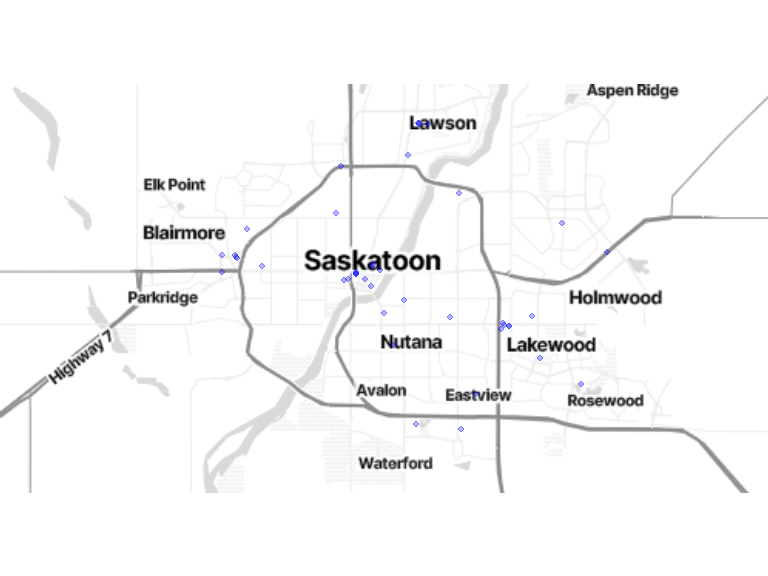
3.7.2 Are there other places that you go to at least once per month that we have not mentioned? For example: a mall, a daycare, a hardware store, or a community center.
NB: Variable other_new has not been properly
recorded in Saskatoon wave 2 for returning participants.
# extract and recode
.other <- veritas_main[c("interact_id", "other_new")] %>% dplyr::rename(other_new_code = other_new)
.other$other_new <- factor(ifelse(.other$other_new_code == 1, "1 [Yes]",
ifelse(.other$other_new_code == 2, "2 [No]", "N/A")
))
# histogram of answers
ggplot(data = .other) +
geom_histogram(aes(x = other_new), stat = "count") +
scale_x_discrete(labels = function(lbl) str_wrap(lbl, width = 20)) +
labs(x = "other_new")
.other_cnt <- .other %>%
group_by(other_new) %>%
dplyr::count() %>%
arrange(other_new)
kable(.other_cnt, caption = "New other places") %>% kable_styling(bootstrap_options = "striped", full_width = T, position = "left")3.8 Section 8: Areas of change
3.8.1 Can you locate areas where you have noticed an improvement of the urban environment?
# extract and recode
.improv <- veritas_main[c("interact_id", "improvement_none")] %>% dplyr::rename(improvement_none_code = improvement_none)
.improv$improvement_none <- factor(ifelse(.improv$improvement_none_code == 1, "1 [TRUE]",
ifelse(.improv$improvement_none_code == 0, "0 [FALSE]", "N/A")
))
# histogram of answers
ggplot(data = .improv) +
geom_histogram(aes(x = improvement_none), stat = "count") +
scale_x_discrete(labels = function(lbl) str_wrap(lbl, width = 20)) +
labs(x = "improvement_none")
.improv_cnt <- .improv %>%
group_by(improvement_none) %>%
dplyr::count() %>%
arrange(improvement_none)
kable(.improv_cnt, caption = "No area of improvement") %>% kable_styling(bootstrap_options = "striped", full_width = T, position = "left")| improvement_none | n |
|---|---|
| 0 [FALSE] | 19 |
| 1 [TRUE] | 44 |
# polgon extraction
improv <- poly_geom[poly_geom$area_type == "improvement", ]
# Map
bm + geom_sf(data = improv, inherit.aes = FALSE, fill = alpha("blue", 0.3), color = alpha("blue", 0.5))
# Min, max, median & mean area of PRN
improv <- improv %>%
mutate(area_m2 = st_area(.))
kable(t(as.matrix(summary(improv$area_m2))),
caption = "Area (in square meters) of the perceived improvement areas",
digits = 1
) %>% kable_styling(bootstrap_options = "striped", full_width = T, position = "left")| Min. | 1st Qu. | Median | Mean | 3rd Qu. | Max. |
|---|---|---|---|---|---|
| 6263.4 | 25218.5 | 93234.7 | 306373.6 | 175202.1 | 2126591 |
3.8.2 Can you locate areas where you have noticed a deterioration of the urban environment?
# extract and recode
.deter <- veritas_main[c("interact_id", "deterioration_none")] %>% dplyr::rename(deterioration_none_code = deterioration_none)
.deter$deterioration_none <- factor(ifelse(.deter$deterioration_none_code == 1, "1 [TRUE]",
ifelse(.deter$deterioration_none_code == 0, "0 [FALSE]", "N/A")
))
# histogram of answers
ggplot(data = .deter) +
geom_histogram(aes(x = deterioration_none), stat = "count") +
scale_x_discrete(labels = function(lbl) str_wrap(lbl, width = 20)) +
labs(x = "deterioration_none")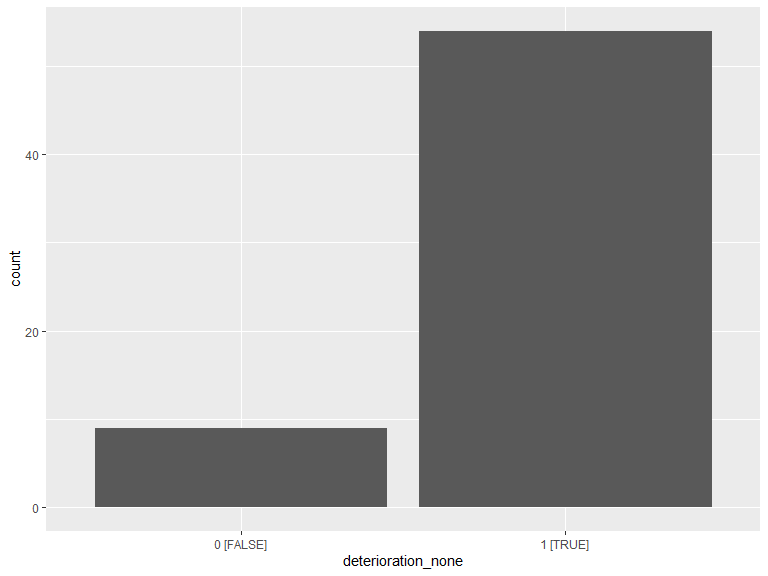
.deter_cnt <- .deter %>%
group_by(deterioration_none) %>%
dplyr::count() %>%
arrange(deterioration_none)
kable(.deter_cnt, caption = "No area of deterioration") %>% kable_styling(bootstrap_options = "striped", full_width = T, position = "left")| deterioration_none | n |
|---|---|
| 0 [FALSE] | 9 |
| 1 [TRUE] | 54 |
# polgon extraction
deter <- poly_geom[poly_geom$area_type == "deterioration", ]
# Map
bm + geom_sf(data = deter, inherit.aes = FALSE, fill = alpha("blue", 0.3), color = alpha("blue", 0.5))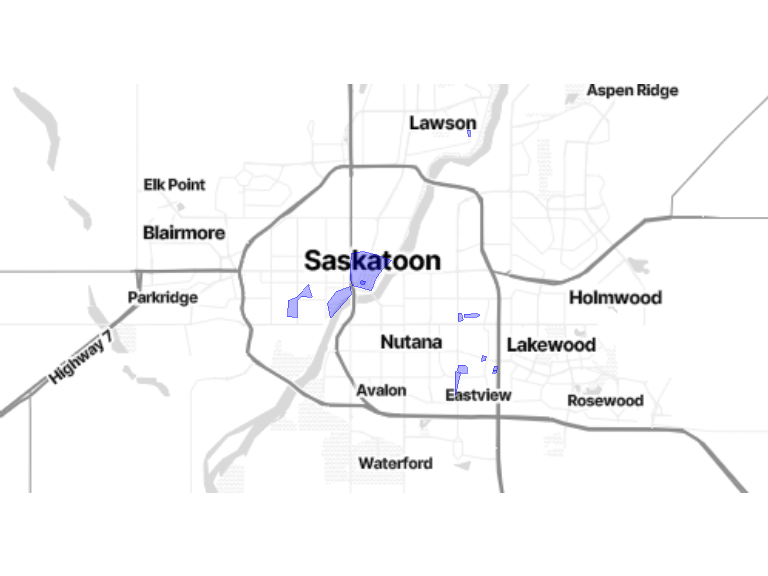
# Min, max, median & mean area of PRN
deter <- deter %>%
mutate(area_m2 = st_area(.))
kable(t(as.matrix(summary(deter$area_m2))),
caption = "Area (in square meters) of the perceived deterioration areas",
digits = 1
) %>%
kable_styling(bootstrap_options = "striped", full_width = T, position = "left")| Min. | 1st Qu. | Median | Mean | 3rd Qu. | Max. |
|---|---|---|---|---|---|
| 1625 | 12642.9 | 72128 | 199827.2 | 265169.7 | 951943.7 |
3.10 Derived metrics
3.10.1 Existence of improvement and deterioration areas by participant
Combination of improvement and/or deterioration areas per participant
# cross tab of improvement vs deteriation areas
.improv <- improv[c("interact_id")] %>%
mutate(improv = "Improvement")
.deter <- deter[c("interact_id")] %>%
mutate(deter = "Deterioration")
.ct_impr_deter <- veritas_main[c("interact_id")] %>%
transmute(interact_id = as.character(interact_id)) %>%
left_join(.improv, by = "interact_id") %>%
left_join(.deter, by = "interact_id") %>%
mutate_all(~ replace(., is.na(.), "N/A"))
kable(table(.ct_impr_deter$improv, .ct_impr_deter$deter), caption = "Improvement vs. deterioration") %>%
kable_styling(bootstrap_options = "striped", full_width = T, position = "left", row_label_position = "r") %>%
column_spec(1, bold = T)| Deterioration | N/A | |
|---|---|---|
| Improvement | 7 | 11 |
| N/A | 2 | 43 |
3.10.2 Transportation mode preferences
Based on the answers to the question Usually, how do you go there? (Check all that apply.).
# code en
# 1 By car and you drive
# 2 By car and someone else drives
# 3 By taxi/Uber
# 4 On foot
# 5 By bike
# 6 By bus
# 7 By subway
# 8 By train
# 99 Other
loc_labels <- data.frame(location_category = c(2:26), description = c(
" 2 [Other residence]",
" 3 [Work]",
" 4 [School/College/University]",
" 5 [Supermarket]",
" 6 [Public/farmer’s market]",
" 7 [Bakery]",
" 8 [Specialty food store]",
" 9 [Convenience store/Dépanneur]",
"10 [Liquor store/SAQ]",
"11 [Bank]",
"12 [Hair salon/barbershop]",
"13 [Post office]",
"14 [Drugstore]",
"15 [Doctor/healthcare provider]",
"16 [Public transit stop]",
"17 [Leisure-time physical activity]",
"18 [Park]",
"19 [Cultural activity]",
"20 [Volunteering place]",
"21 [Religious/spiritual activity]",
"22 [Restaurant, café, bar, etc.]",
"23 [Take-out]",
"24 [Walk]",
"25 [Other place]",
"26 [Social contact residence]"
))
# extract and summary stats
.tm <- locations %>%
st_set_geometry(NULL) %>%
filter(location_category != 1 & location_current == 1) %>%
left_join(loc_labels)
.tm_grouped <- .tm %>%
group_by(description) %>%
dplyr::summarise(
N = n(), "By car (driver)" = sum(location_tmode_1),
"By car (passenger)" = sum(location_tmode_2),
"By taxi/Uber" = sum(location_tmode_3),
"On foot" = sum(location_tmode_4),
"By bike" = sum(location_tmode_5),
"By bus" = sum(location_tmode_6),
"By train" = sum(location_tmode_7),
"Other" = sum(location_tmode_99)
)
kable(.tm_grouped, caption = "Transportation mode preferences") %>% kable_styling(bootstrap_options = "striped", full_width = T, position = "left")| description | N | By car (driver) | By car (passenger) | By taxi/Uber | On foot | By bike | By bus | By train | Other |
|---|---|---|---|---|---|---|---|---|---|
| 2 [Other residence] | 6 | 2 | 3 | 0 | 1 | 0 | 4 | 0 | 0 |
| 3 [Work] | 67 | 18 | 10 | 2 | 9 | 5 | 17 | 0 | 27 |
| 4 [School/College/University] | 12 | 3 | 2 | 0 | 3 | 1 | 3 | 0 | 4 |
| 5 [Supermarket] | 155 | 88 | 41 | 3 | 30 | 7 | 21 | 0 | 3 |
| 6 [Public/farmer’s market] | 5 | 3 | 0 | 0 | 1 | 2 | 0 | 0 | 0 |
| 7 [Bakery] | 14 | 3 | 6 | 0 | 5 | 1 | 0 | 0 | 0 |
| 8 [Specialty food store] | 29 | 17 | 5 | 0 | 7 | 2 | 0 | 0 | 1 |
| 9 [Convenience store/Dépanneur] | 18 | 4 | 0 | 0 | 9 | 1 | 6 | 0 | 0 |
| 10 [Liquor store/SAQ] | 25 | 15 | 2 | 0 | 5 | 3 | 4 | 0 | 0 |
| 11 [Bank] | 26 | 14 | 4 | 0 | 7 | 2 | 2 | 0 | 2 |
| 12 [Hair salon/barbershop] | 21 | 10 | 1 | 1 | 8 | 1 | 4 | 0 | 1 |
| 13 [Post office] | 25 | 11 | 4 | 0 | 12 | 2 | 6 | 0 | 0 |
| 14 [Drugstore] | 37 | 19 | 5 | 0 | 15 | 3 | 3 | 0 | 2 |
| 15 [Doctor/healthcare provider] | 48 | 28 | 7 | 4 | 6 | 1 | 11 | 0 | 2 |
| 16 [Public transit stop] | 52 | 0 | 0 | 0 | 46 | 0 | 10 | 0 | 1 |
| 17 [Leisure-time physical activity] | 19 | 10 | 2 | 0 | 8 | 3 | 0 | 0 | 0 |
| 18 [Park] | 42 | 4 | 2 | 0 | 35 | 5 | 0 | 0 | 0 |
| 19 [Cultural activity] | 6 | 3 | 0 | 0 | 2 | 0 | 1 | 0 | 0 |
| 20 [Volunteering place] | 10 | 4 | 1 | 0 | 2 | 1 | 1 | 0 | 3 |
| 21 [Religious/spiritual activity] | 6 | 2 | 2 | 0 | 1 | 0 | 1 | 0 | 2 |
| 22 [Restaurant, café, bar, etc.] | 49 | 17 | 13 | 1 | 17 | 3 | 7 | 0 | 2 |
| 23 [Take-out] | 20 | 10 | 6 | 0 | 3 | 0 | 2 | 0 | 2 |
| 24 [Walk] | 44 | 3 | 4 | 0 | 41 | 4 | 1 | 0 | 0 |
| 25 [Other place] | 44 | 19 | 13 | 0 | 14 | 7 | 7 | 0 | 0 |
# graph
.tm1 <- .tm %>%
filter(location_tmode_1 == 1) %>%
mutate(tm = "[1] By car (driver)")
.tm2 <- .tm %>%
filter(location_tmode_2 == 1) %>%
mutate(tm = "[2] By car (passenger)")
.tm3 <- .tm %>%
filter(location_tmode_3 == 1) %>%
mutate(tm = "[3] By taxi/Uber")
.tm4 <- .tm %>%
filter(location_tmode_4 == 1) %>%
mutate(tm = "[4] On foot")
.tm5 <- .tm %>%
filter(location_tmode_5 == 1) %>%
mutate(tm = "[5] By bike")
.tm6 <- .tm %>%
filter(location_tmode_6 == 1) %>%
mutate(tm = "[6] By bus")
# .tm7 <- .tm %>% # Empty dataframe -> error when creating tm col.
# filter(location_tmode_7 == 1) %>%
# mutate(tm = "[7] By train")
.tm99 <- .tm %>%
filter(location_tmode_99 == 1) %>%
mutate(tm = "[99] Other")
.tm <- bind_rows(.tm1, .tm2) %>%
bind_rows(.tm3) %>%
bind_rows(.tm4) %>%
bind_rows(.tm5) %>%
bind_rows(.tm6) %>%
# bind_rows(.tm7) %>%
bind_rows(.tm99)
# histogram of answers
ggplot(data = .tm) +
geom_bar(aes(x = fct_rev(description), fill = tm), position = "fill") +
scale_fill_brewer(palette = "Set3", name = "Transport modes") +
scale_y_continuous(labels = percent) +
labs(y = "Proportion of transportation mode by location category", x = element_blank()) +
coord_flip() +
theme(legend.position = "bottom", legend.justification = c(0, 0), legend.text = element_text(size = 8)) +
guides(fill = guide_legend(nrow = 3))
3.10.3 Visiting places alone
Based on the answers to the question Do you usually go to this place alone or with other people?.
loc_labels <- data.frame(location_category = c(2:26), description = c(
" 2 [Other residence]",
" 3 [Work]",
" 4 [School/College/University]",
" 5 [Supermarket]",
" 6 [Public/farmer’s market]",
" 7 [Bakery]",
" 8 [Specialty food store]",
" 9 [Convenience store/Dépanneur]",
"10 [Liquor store/SAQ]",
"11 [Bank]",
"12 [Hair salon/barbershop]",
"13 [Post office]",
"14 [Drugstore]",
"15 [Doctor/healthcare provider]",
"16 [Public transit stop]",
"17 [Leisure-time physical activity]",
"18 [Park]",
"19 [Cultural activity]",
"20 [Volunteering place]",
"21 [Religious/spiritual activity]",
"22 [Restaurant, café, bar, etc.]",
"23 [Take-out]",
"24 [Walk]",
"25 [Other place]",
"26 [Social contact residence]"
))
# extract and summary stats
.alone <- locations %>%
st_set_geometry(NULL) %>%
filter(location_category != 1 & location_current == 1) %>%
left_join(loc_labels) %>%
mutate(location_alone_recode = case_when(
location_alone2 == 1 ~ 1,
location_alone2 == 2 ~ 0
))
.alone_grouped <- .alone %>%
group_by(description) %>%
dplyr::summarise(
N = n(), "Visited alone" = sum(location_alone_recode),
"Visited alone (%)" = round(sum(location_alone_recode) * 100.0 / n(), digits = 1)
)
kable(.alone_grouped, caption = "Visiting places alone") %>% kable_styling(bootstrap_options = "striped", full_width = T, position = "left")| description | N | Visited alone | Visited alone (%) |
|---|---|---|---|
| 2 [Other residence] | 6 | 1 | 16.7 |
| 3 [Work] | 67 | 32 | 47.8 |
| 4 [School/College/University] | 12 | 6 | 50.0 |
| 5 [Supermarket] | 155 | 100 | 64.5 |
| 6 [Public/farmer’s market] | 5 | 4 | 80.0 |
| 7 [Bakery] | 14 | 6 | 42.9 |
| 8 [Specialty food store] | 29 | 20 | 69.0 |
| 9 [Convenience store/Dépanneur] | 18 | 16 | 88.9 |
| 10 [Liquor store/SAQ] | 25 | 18 | 72.0 |
| 11 [Bank] | 26 | 26 | 100.0 |
| 12 [Hair salon/barbershop] | 21 | 19 | 90.5 |
| 13 [Post office] | 25 | 22 | 88.0 |
| 14 [Drugstore] | 37 | 32 | 86.5 |
| 15 [Doctor/healthcare provider] | 48 | 43 | 89.6 |
| 16 [Public transit stop] | 52 | 49 | 94.2 |
| 17 [Leisure-time physical activity] | 19 | 7 | 36.8 |
| 18 [Park] | 42 | 15 | 35.7 |
| 19 [Cultural activity] | 6 | 4 | 66.7 |
| 20 [Volunteering place] | 10 | 4 | 40.0 |
| 21 [Religious/spiritual activity] | 6 | 4 | 66.7 |
| 22 [Restaurant, café, bar, etc.] | 49 | 17 | 34.7 |
| 23 [Take-out] | 20 | 13 | 65.0 |
| 24 [Walk] | 44 | 13 | 29.5 |
| 25 [Other place] | 44 | 28 | 63.6 |
# histogram of answers
ggplot(data = .alone) +
geom_bar(aes(x = fct_rev(description), fill = factor(location_alone2)), position = "fill") +
scale_fill_brewer(palette = "Set3", name = "Visiting places", labels = c("N/A", "Alone", "With someone")) +
scale_y_continuous(labels = percent) +
labs(y = "Proportion of places visited alone", x = element_blank()) +
coord_flip()
3.10.4 Visit frequency
Based on the answers to the question How often do you go there?.
loc_labels <- data.frame(location_category = c(2:26), description = c(
" 2 [Other residence]",
" 3 [Work]",
" 4 [School/College/University]",
" 5 [Supermarket]",
" 6 [Public/farmer’s market]",
" 7 [Bakery]",
" 8 [Specialty food store]",
" 9 [Convenience store/Dépanneur]",
"10 [Liquor store/SAQ]",
"11 [Bank]",
"12 [Hair salon/barbershop]",
"13 [Post office]",
"14 [Drugstore]",
"15 [Doctor/healthcare provider]",
"16 [Public transit stop]",
"17 [Leisure-time physical activity]",
"18 [Park]",
"19 [Cultural activity]",
"20 [Volunteering place]",
"21 [Religious/spiritual activity]",
"22 [Restaurant, café, bar, etc.]",
"23 [Take-out]",
"24 [Walk]",
"25 [Other place]",
"26 [Social contact residence]"
))
# extract and summary stats
.freq <- locations %>%
st_set_geometry(NULL) %>%
filter(location_category != 1 & location_current == 1) %>%
left_join(loc_labels)
.freq_grouped <- .freq %>%
group_by(description) %>%
dplyr::summarise(
N = n(), min = min(location_freq_visit),
max = max(location_freq_visit),
mean = mean(location_freq_visit),
median = median(location_freq_visit),
sd = sd(location_freq_visit)
)
kable(.freq_grouped, caption = "Visit frequency (expressed in times/year)") %>% kable_styling(bootstrap_options = "striped", full_width = T, position = "left")| description | N | min | max | mean | median | sd |
|---|---|---|---|---|---|---|
| 2 [Other residence] | 6 | 24 | 364 | 146.666667 | 130 | 136.976884 |
| 3 [Work] | 67 | 0 | 365 | 196.328358 | 260 | 138.880959 |
| 4 [School/College/University] | 12 | 0 | 1040 | 269.083333 | 312 | 294.441060 |
| 5 [Supermarket] | 155 | 0 | 260 | 34.819355 | 24 | 38.644815 |
| 6 [Public/farmer’s market] | 5 | 1 | 52 | 33.800000 | 52 | 25.223005 |
| 7 [Bakery] | 14 | 6 | 104 | 26.142857 | 24 | 25.059490 |
| 8 [Specialty food store] | 29 | 2 | 24 | 10.965517 | 12 | 7.193662 |
| 9 [Convenience store/Dépanneur] | 18 | 2 | 260 | 65.388889 | 18 | 83.981188 |
| 10 [Liquor store/SAQ] | 25 | 1 | 156 | 22.880000 | 12 | 34.604094 |
| 11 [Bank] | 26 | 0 | 12 | 6.500000 | 4 | 4.925444 |
| 12 [Hair salon/barbershop] | 21 | 1 | 12 | 5.619048 | 5 | 4.443829 |
| 13 [Post office] | 25 | 2 | 52 | 11.040000 | 5 | 12.306773 |
| 14 [Drugstore] | 37 | 1 | 104 | 19.378378 | 12 | 22.395872 |
| 15 [Doctor/healthcare provider] | 48 | 0 | 48 | 5.791667 | 2 | 8.039684 |
| 16 [Public transit stop] | 52 | 0 | 1040 | 125.096154 | 50 | 193.168448 |
| 17 [Leisure-time physical activity] | 19 | 12 | 364 | 85.263158 | 36 | 101.998280 |
| 18 [Park] | 42 | 2 | 260 | 84.428571 | 52 | 81.751898 |
| 19 [Cultural activity] | 6 | 0 | 104 | 39.000000 | 12 | 50.592490 |
| 20 [Volunteering place] | 10 | 12 | 156 | 69.600000 | 52 | 56.480478 |
| 21 [Religious/spiritual activity] | 6 | 8 | 364 | 157.333333 | 78 | 162.946208 |
| 22 [Restaurant, café, bar, etc.] | 49 | 0 | 208 | 22.000000 | 12 | 32.348364 |
| 23 [Take-out] | 20 | 1 | 52 | 13.750000 | 12 | 11.728844 |
| 24 [Walk] | 44 | 2 | 936 | 125.409091 | 52 | 156.651341 |
| 25 [Other place] | 44 | 0 | 156 | 27.113636 | 12 | 29.405122 |
# graph
ggplot(data = .freq) +
geom_boxplot(aes(x = fct_rev(description), y = location_freq_visit)) +
scale_y_continuous(limits = c(0, 365)) +
labs(y = "Visits/year (Frequency over 1 visit/day not shown)", x = element_blank()) +
coord_flip()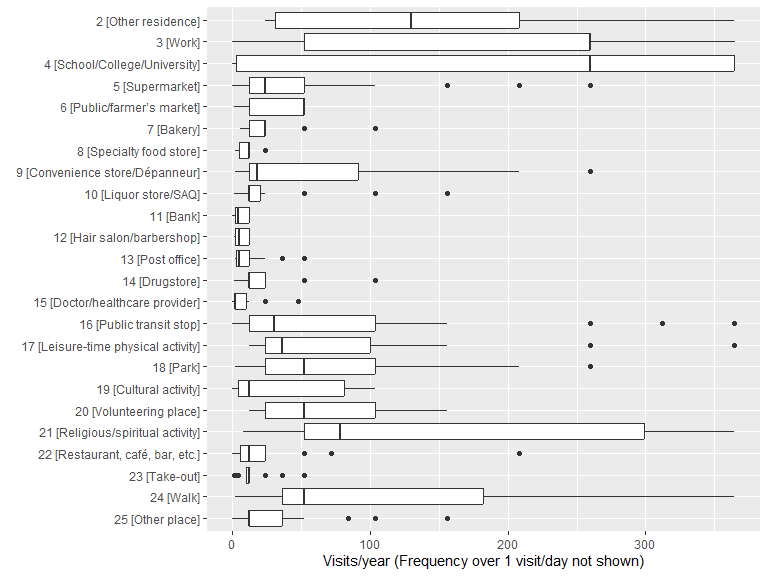
3.10.5 Spatial indicators: Camille Perchoux’s toolbox
Below is a list of indicators proposed by Camille Perchoux in her paper Assessing patterns of spatial behavior in health studies: Their socio-demographic determinants and associations with transportation modes (the RECORD Cohort Study).
-- Reading Camille tbx indics from Essence table
SELECT interact_id,
n_acti_places, n_weekly_vst, n_acti_types,
cvx_perimeter, cvx_surface,
min_length, max_length, median_length,
pct_visits_neighb,
n_acti_prn, pct_visits_prn, prn_area_km2
FROM essence_table.essence_perchoux_tbx
WHERE city_id = 'Saskatoon' AND wave_id = 2 AND status = 'return'

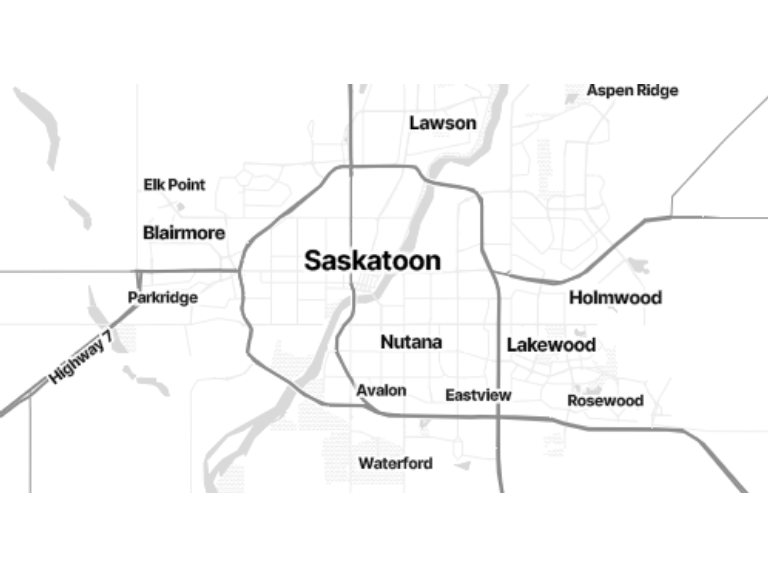

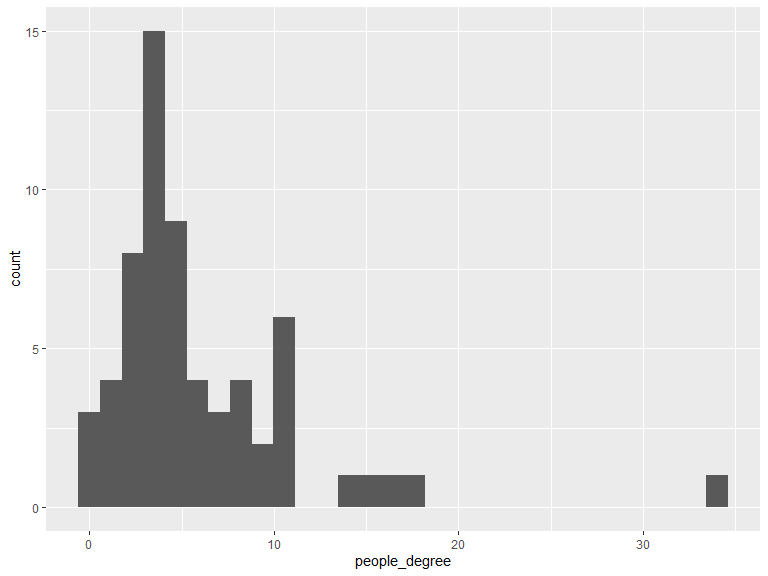
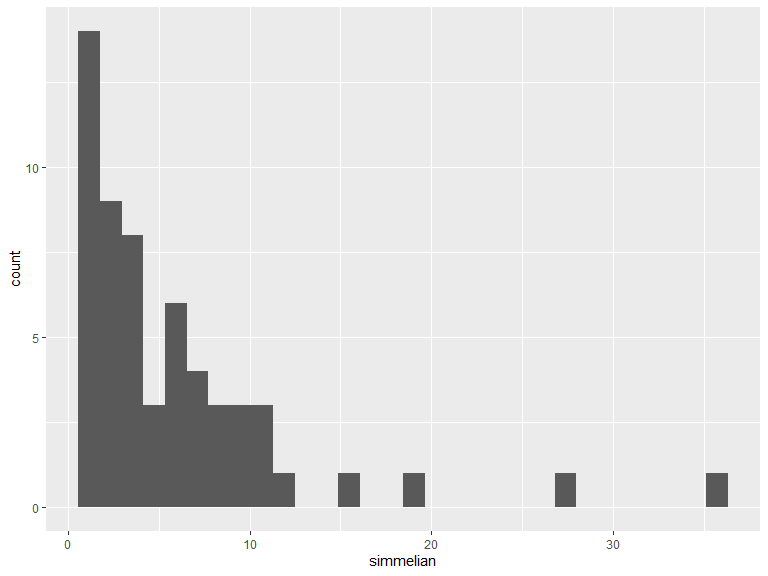


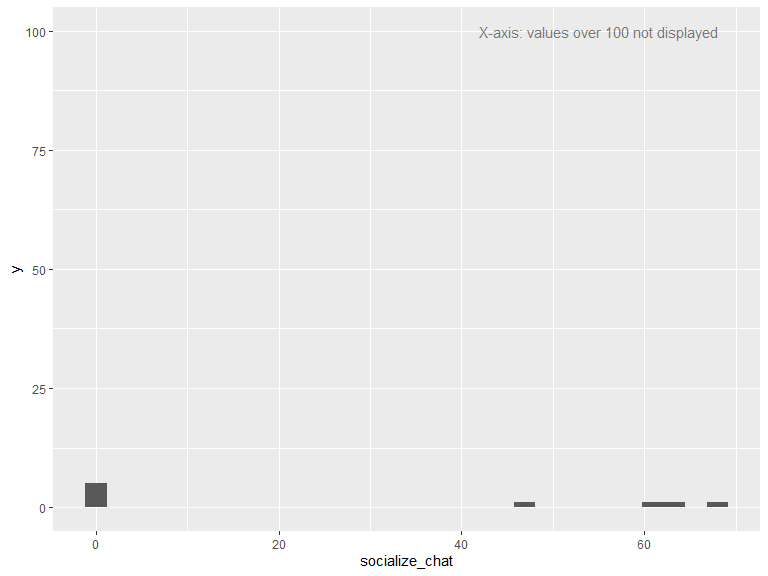

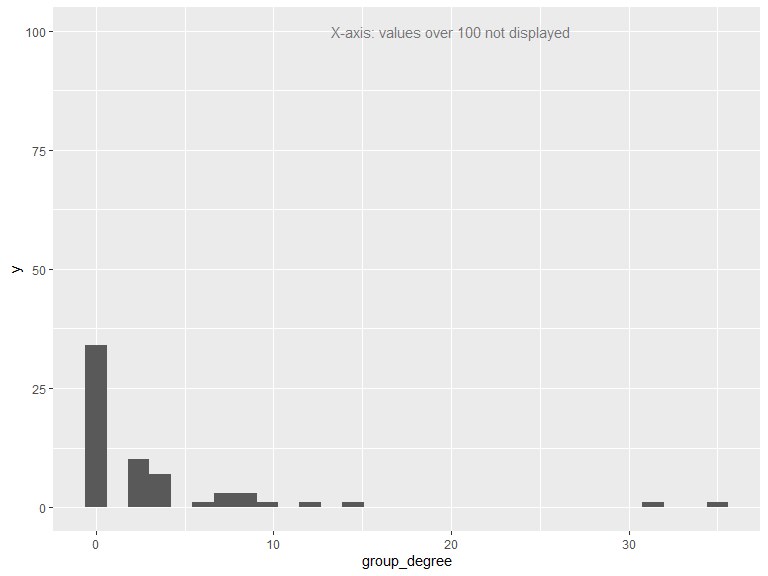
2.10.6 Social indicators: Alexandre Naud’s toolbox
See Alex’s document for a more comprehensive presentation of the social indicators.
2.10.6.1 Number of people in the network (
people_degree)2.10.6.2 Simmelian Brokerage (
simmelian)2.10.6.3 Number of people with whom the participant like to socialize (
socialize_size)2.10.6.4 Weekly face-to-face interactions among people with whom the participant like to socialize (
socialize_meet)2.10.6.5 Weekly ICT interactions among people with whom the participant like to socialize (
socialize_chat)2.10.6.6 Number of people with whom the participant discuss important matters (
important_size)2.10.6.7 Number of people in all groups (
group_degree)